#really illustrates how her album vocals are literally just her
Explore tagged Tumblr posts
Text



billie eilish (and finneas) npr tiny desk concert
could she be any more endearing to me personally
#billie eilish#finneas#billieeilishedit#beilishedit#billie and finneas#tiny desk concert#npr#billiegifs#billiefinneasgifs#mygifs#she and finneas and the band killed it. BOAF was not my favorite but the other 3 were absolutely gorgeous and her voice 💜#really illustrates how her album vocals are literally just her#they both make me smile
89 notes
·
View notes
Text
In honor of me having so much video game music downloaded on my phone that I ran out of storage and had to buy a new phone. My favorite track from each video game OST I have!
Bastion: Brusher Patrol (Such a bizarre clash of styles, I can't help but love this one. Shout-out to the part that sounds like Darren quietly scatting in the background.) (Also special shout-out to Build That Wall, probably my favorite vocal track in any Supergiant game)
Celeste: Scattered and Lost (I am such a normie for this choice but face it this track absolutely slaps.)
Chicory: A Colorful Tale: Song of the Wielders (I love how this song has actual lyrics but I still prefer to sing along with the Simlish version that Pizza and Chicory sing.)
The Cosmic Wheel Sisterhood: Illusion (First of all I love how every character in this game has their own theme I go feral for that kind of thing. Kurielle is probably one of the characters who stood out to me the least but by god is her theme gorgeous. I love the vocals and how a later track includes a sneaky reprise.)
Cuphead: Dramatic Fanatic (Tap dancing :D)
There are literally thirty of these so I'm doing a read more
Death's Door: The Grey Crow (A heartbreaking boss fight scored with the appropriate amount of anguish)
Deltarune: Cyber Battle (This melody is so underrated and ya know what, so are the characters associated with it. Sweet Cap'n Cakes forever.)
Elsinore: Donne, The Boat Boy (I love this song because it's associated with Lady Guildenstern, aka the best character in gaming full stop, but it's also just a fun little sea shanty that I think they made up for this game so I love that. Also has a lyrical version.)
Evergate: Police (Okay so the level with the police drones is one of the more frustrating ones in the game but the music is hauntingly beautiful so I give it a pass)
Going Under: trust fall (Marv is easily one of the most hateable video game antagonists of all time but damn if his boss theme doesn't slap)
Hades: Last Words (The rolling and the tolling of the bells bells bells bells bells)
Harmony: The Fall of Reverie: Reverie Ascendant (Lena Raine does these medley tracks so good man)
Hollow Knight: Dung Defender (By far the catchiest song about poop on my entire phone)
Ikenfell: Rose Thorns (So the insanely long final boss fight against Oxley overshadowed Aeldra's boss fight in my memory for a long time, but when I watched another playthrough and bought the OST I realized "Oh her theme bops SO much harder than his ever could")
Inscryption: A Final Duel (A hardcore remix of The Scrybe of Magicks, aka one of the only melodic tracks on the album and therefore the one every YouTube video about Inscryption uses in the background. I prefer the epic version just a bit more because honestly that Magnificus setpiece is the best moment in the game)
Jimmy and the Pulsating Mass: Fun, Sunny Day (A fun and silly track as the title suggests, elevated even more by the context in which it plays in the game. The area music alternates between this and the more somber Rainy Sunday to illustrate that Jimmy mother is bipolar [very cute and silly game])
Omori: Bready Steady Go (Like the absolute dipshit I am I actually completely missed the optional Orange Oasis when I played this game myself. Every Let's Player finds it somehow, though, and when they fight the Unbread Twins I invariably stand up and dance along to the boss music.)
One Step from Eden: Perpetual Motion (It's just a good-ass track y'all)
Ori and the Blind Forest: Conundrum (In a soundtrack of sweeping orchestral pieces, this more subdued version of theme that only plays during one small puzzle section might seem a weird choice. But I've always really liked it)
Ori and the Will of the Wisps: Kwolok's Malaise (Kwolok's leitmotif is perfect for a giant frog and the boss remix takes it to it's logical conclusion)
Paradise Killer: Go! Go! Style (This track makes me feel like I'm having a sugar rush. The whole OST does actually but this one especially)
Pyre: Path to Glory (It's just got a really unique vibe to it. I like it)
Scarlet Hollow: Avery (Chill and really beautiful. Avery themself is kind of a sleeper character at this point but I can't wait for Brandon to remix their theme when they get assimilated into a giant plant monster)
Slay the Princess: The Princess (Okay full disclosure I've only played this game once so I don't have the full context for a lot of the tracks on this OST. Maybe hearing them alongside their respective princesses will make me like them more, but for now the title theme is too iconic to beat.)
Sounds of Sympathy (the OST for the game anthology Essays on Empathy): Zen and the Art of Transhumanism (In the Essays on Empathy documentary, fingerspit talked about how she prefers writing obscenely long tracks so the loop doesn't get annoying. Unfortunately for her my favorite track on this album is only three minutes long. It's a lovely little bop.)
Spiritfarer: Mind Palace (I played Spiritfarer before any of the character updates were released, so I didn't get Daria's mind palace sequences in my game. And I mean, they look very platforming-heavy so I'm okay with that, but god this is a gorgeous piece.)
Transistor: Impossible (I think this is Royce Bracket's boss theme? I don't know when any of the tracks on this OST specifically play in game. Regardless of all that this one gets me pumped.)
Unavowed: One Man's Power (I couldn't find a video of this one, but it's gentle saxophone solo that plays when Logan Brown is introduced. I think it fits is character really well and just sounds really nice)
Undertale: Death by Glamour (Best song for best character, enough said)
Wandersong: Moonscape (God knows this game gave me a lot of great options to pick from, but I settled on this one because it's so uplifting.)
#bastion#celeste#chicory: a colorful tale#the cosmic wheel sisterhood#cuphead#death's door#deltarune#elsinore#evergate#going under#hades game#harmony: the fall of reverie#hollow knight#ikenfell#inscryption#jimmy and the pulsating mass#omori#one step from eden#ori and the blind forest#paradise killer#pyre#scarlet hollow#slay the princess#essays on empathy#spiritfarer#transistor#unavowed#undertale#wandersong
62 notes
·
View notes
Text
speculating about the "plot" of my favorite album of 2023 (Married in Mount Airy, Nicole Dollanganger) 🍸🤍🌙💎💒
(Unedited)
Before going into spoilers/the album's storyline, I want to commend how STELLAR the album's production was, and how far @nicoledollanganger has come since starting out making dream pop recorded in her bathroom/bedroom on garage band (still love that music, but the progress speaks for itself imo). This album is nothing less than hauntingly beautiful, aided in no small part by the final composition and how the story is woven amid the vocals, instrumentation and lyrics. It's the kind of music so good it makes me want to SCREAM, on god.
Favorite tracks were: Married in Mount Airy, Gold Satin Dreamer, Whispering Glades, Nymphs Finding the Head of Orpheus and Moonlite
(Spoilers below, duh)
my interpretation of the story told by the album starts with the bride running away with her husband on their honeymoon (Married in Mount Airy) Their good times together, though with an underlining eeriness resting below the surface (Gold Satin Dreamer and Runnin' Free). The husband relapsing/worsening alcoholism and violent temper (Dogwood) The bride begging her husband to stop drinking and the violent behavior (My Darling True) Knowing what she has to do, but overwhelmed with fear and hesitation- she knows what she has to do if she wants to live, and she has a feeling tonight's the night, but she can't help but fear having to go through with it. (Some Time After Midnight)
The bride's ultimatum to put an end to the toxic relationship with her husband confessing to the murder of her husband. (Bad Man) The Bride shoots her husband late in the night, leaving him to rot in the forest/reflecting on how bad they were for one another. (Nymphs finding the Head of Orpheus) Reflecting on what might have been the "worst" most dangerous nights shared with her ex-husband (Moonlite) Making her peace with what she's done, laying all the love she once had for her ex-husband to rest. (Whispering Glades)
The final track I'll Wait for Your Call is extremely bittersweet because, even after everything the Bride has gone through, and all she's done, there will always be a part of her that loves her ex-husband. And even in death, she can't help loving him from afar, and dreams about reuniting with him in the afterlife.
Also of note is how the ending instrumentation of "I'll Wait for your call" perfectly mirrors the opening music for the opening track, like a tragic ouroboros. IMO, the perfect way to end an album written to sound like a surreal dream you can't awaken from. Like Mount Airy is this fucked up purgatory for these two sinners cursed to remain tethered together till the end of time. The Groom cursed to relive a hell of his own making (constant drinking, endless wrath, stuck with a woman who loves him less and less with each passing day) and the Bride cursed to remain in the abusive relationship as punishment for her murder.
Heartbreaking, haunting- but undeniably beautiful. It's everything I love about Dream Pop and more, it was well worth the wait.
and like MY GODDDD, not to "spoil" the ending of the album (but also it's hard to spoil an album like this considering it's just something you gotta experience as a whole, but i digress) it's so brilliant to have the line "Where all you have to bring is your love of everything" from the MIMA's opening track work in tandem with the line "There's a spot in the grass in the grass waiting for you at Whispering Glades" Bringing the tale of a bride running away with her groom on their honeymoon; their love story ending with the bride murdering her husband and laying him to where she leaves her love of everything. Literally going from Married in Mount Airy to Buried in Mount Airy

My one nitpick here is that i'm not too crazy about the album's cover. I really love how she usually illustrates her own cover art for albums/EPs, and the image used is very uncanny valley and a bit stilted to me.
(but you know, this is completely subjective, and at least it's better than the cover for Heart Shaped Bed, again in my opinion. maybe i only feel this way bc there were so many lovely promos dropped before the album, i can't help but compare them. Idk why, but there's something so compelling about the image of her with the wired phone- I would personally vouch for that one as cover art)
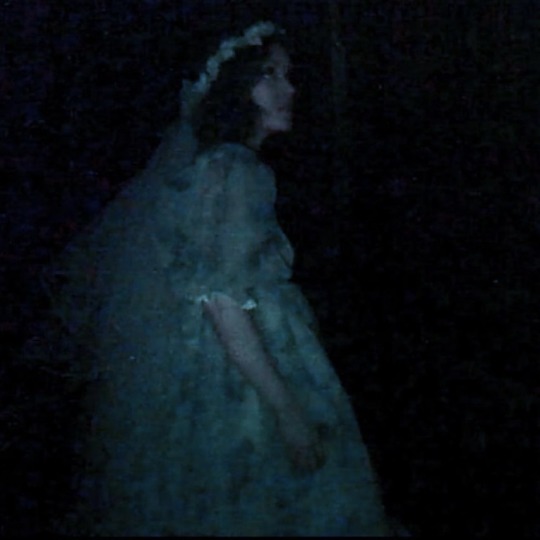



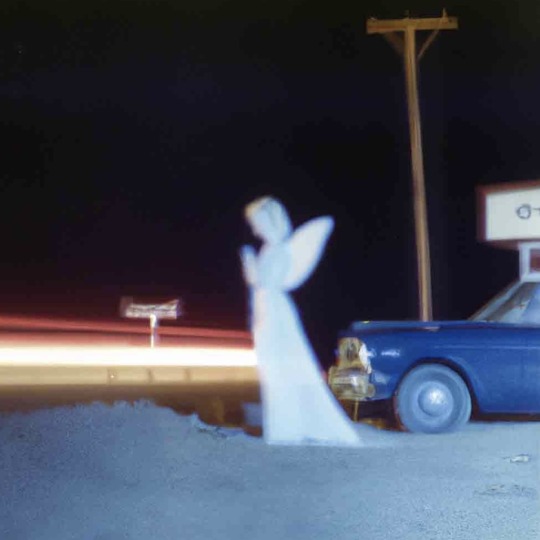

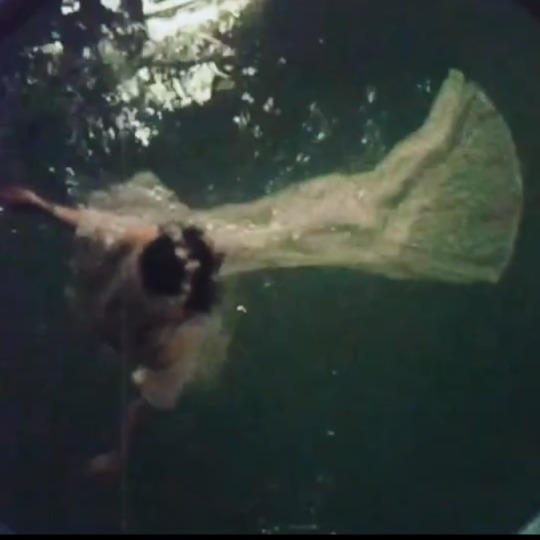
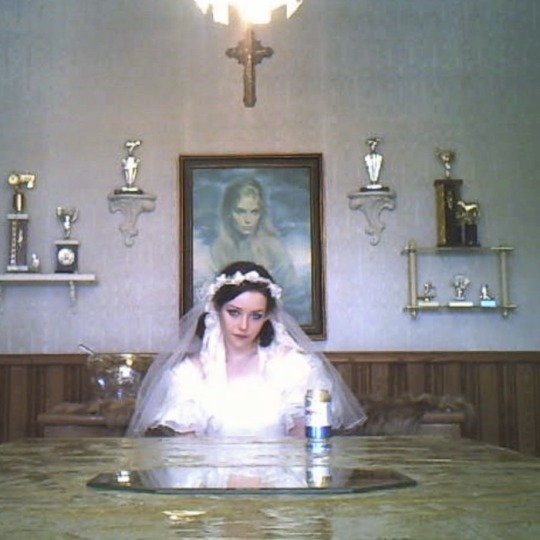
5 notes
·
View notes
Text
Georgia Anne Muldrow Interview: Rhythm Is A Form of Gravity

Photo by Antoinette A. Brock
BY JORDAN MAINZER
“The people keep you fresh. They keep you on your toes,” Georgia Anne Muldrow told me over the phone last month. The prolific L.A. musician, whose output ranges from experimental hip-hop to neo soul to jazz and everything in between, is releasing her fifth record in four years on Friday, and the third overall in her beats series. VWETO III (FORESEEN + Epistrophik Peach Sound) follows last year’s Mama, You Can Bet! (released under the name Jyoti), 2019′s collaboration with Dudley Perkins and VWETO II, and 2018′s acclaimed, Grammy-nominated Overload. Unlike any of the previous albums, it was put together with some “calls to action” in mind.
Thought some of the songs were around for longer, VWETO III as an entity was made last year, “over a course of time where things were changing in terms of different recording techniques I was trying,” said Muldrow, harking back to techniques and inspirations from her early years of music making. The record was also, obviously, formed during a global pandemic that caused folks to lock down, and Muldrow is conscious to giving listeners opportunities to reach out on her very active Instagram account. Each of the album’s singles have been paired with those aforementioned calls to action. “Unforgettable”, which combines 80′s-sounding synths with 90′s G-funk, calls for vocalists to submit performances to go along with Muldrow’s vocals on the song. “Mufaro’s Garden”, inspired by an illustrated folktale book called Mufaro's Beautiful Daughters, asks for visual artist submissions. On the day of the album’s release, Muldrow will ask for dance submissions to “Slow Drag”, a throwback Hammond-guitar-piano ditty named after the juke joint dance of the same name. Next month, it’ll be “Action Groove”, with calls for turntable scratch ‘n’ sampling remixes from DJs. And it’s not just the singles that exemplify Muldrow’s desire to connect with listeners on a granular level. Many of the songs on VWETO III refer to or are inspired by specific eras, from the Afrofuturist jazz of “Afro AF” to the genre tribute “Boom Bap Is My Homegirl”. That the titles are clearly referential, too, like “Old Jack Swing” or “Synthmania Rock”, shows that Muldrow’s not winking and nodding or trying to fool us, earnestly inviting us to dive in.
Moreover, VWETO III is coinciding with what Muldrow’s calling the Teacherie, classes she’s trying to develop to spread knowledge of what she’s learned throughout her own career, everything from philosophy to instrumental-specific classes. Right now, from her saved Instagram story called “Teacherie!,” you can take an assessment to fill out what you’re interested in. “It helps me to see what skill levels people have and what they want to learn in the class,” Muldrow said. “I seek to continue to stay open enough to make relevant music and have relevant things to share with people.” Overall, Muldrow is the type of artist that uses online platforms the way they’d be used in an ideal world. Her use of NFTs, too, is noble; the album art by Cape Town-based Breeze Yoko is being auctioned off, with 50% of proceeds going to prison abolitionist organization Critical Resistance. Even when the offline world returns--Muldrow’s slated to play Pitchfork Music Festival on Saturday, September 11th--Muldrow’s created a blueprint for navigating an increasingly isolating digital world, by seeking out real connections.
Below, read my conversation with Muldrow, edited for length and clarity, as she discusses making the record, being inspired by African rhythms, the influence of Digital Underground, and why her work logically extends into prison abolition. You can also catch her tomorrow on Bandcamp Live at 8 PM CST.
Since I Left You: Why did you decide this was a good time to revisit your beats album series?
Georgia Anne Muldrow: The people love it, you know? I always like to post beats on Instagram and share my poetry or state of mind of what’s going on in the world according to my people, and provide a place of joy and uplift. The voice of the people kind of determined what songs were on there. There are some songs that nobody’s ever heard. Different ideas, something a little bit more energized.
Something for the people. It’s really great that I have direct contact with them. Some of the songs are things I like to try based on the vibes I get from their feedback. It’s great; it’s a beautiful thing for me. I’ve gone through phases where critics love me, but the voice of the people that really support your work is really cool to hear. It’s like a little focus group. I just like sharing my music with folks because it’s my way of contributing love energy to the world in a direct, immediate way.
SILY: A lot of folks are still staying home and needing that connection. You’re connecting with them but also providing a platform for them to connect with each other.
GAM: Yes. I’m way into that and seek to be expanding that in an even more literal sense with my classroom project [Teacherie], like a live webinar sort of thing, that enables folks to speak amongst themselves. A more extended form of what I do on social media. An intimate look at what’s really going on in music. They can see where my emotions end and the music begins and try to make things seamless within their own music. Teach what I’ve picked up along the way, because I won’t be here forever. Spreading the love but the knowledge, too, with the music that I share. There’s a certain quality that you can achieve if you have patience.
SILY: Did you always know you wanted to do these calls for action, like for vocalists on “Unforgettable”? And how did you decide which tracks you wanted to do them for?
GAM: It’s definitely my way of trying to promote some sort of hip hop jam in lieu of the isolation that folks are weathering...I’m really inspired by the early age of hip hop where everyone had different dances. They brought their art books to the hip hop jams. The jackets with the art on it, the MCs rapping. The breakdancing, the DJs. All of the different things in place for it to be complete. That’s part of what got me hooked on production. One night years ago, [when I first played] my stuff, and folks started to dance, it got me hooked--to make somebody move. Somebody can rap over this, somebody can dance to this or draw to this. That’s the reason for the calls to action. Opening up a hip hop jam all over the world. I hope it gains some momentum. That would be nice, for more people to put themselves out there. But I do understand we live in different times right now and people are trying to get by. I still have to post some of the artists from “Mufaro’s Garden” and these rap videos from “Unforgettable”.
SILY: You’re giving people an opportunity, even if they’re just trying to get through the day, to take a break or have a beneficial creative exercise.
GAM: Yeah. Being creative together, and togetherness. The thinking that the songs aren’t complete without dance. Lyrics are a certain kind of fulfillment of music. But the movement of the body is another one. [It] goes back to gravity. Drummers harness the power of gravity and manipulate it so things can fall at a certain time. Same thing with dance--[dancers] don’t manipulate gravity, but interact with it and create an interdependence with it. When somebody’s dancing, they come back down to the ground, and you could let that go and let gravity guide what your dance looks like. Rhythm is a form of gravity--a form of gravity engaging with life. I feel like movement is the fulfillment of all the arts. I just seek to do my part.
SILY: You mentioned being inspired by a specific early era in hip hop, and there’s a lot on here inspired by genre or era-specific trends, like the G-funk in “Unforgettable” and “Boom Bap Is My Homegirl”.
GAM: [Boom bap] is one of the things that I specialize in. It’s a home base for me. In my experience, it’s a very African point of access. A lot of the boom bap rhythms are straight from Africa. Most of them are. Off the shores of West Africa. I heard so many of them, from The Gambia, Senegal, Mali. Over there, you hear so much of it. I want to be part of that. At the same time, I might wake up and make a free jazz record. I don’t feel like a traditionalist; I just want to preserve the culture of Black music from this hemisphere. I love traditional ideas, but it’s not like I’m gonna do this one idea for the sake of staying in a lane. There’s no place that Black music hasn’t influenced, molded, shaped, nurtured.
SILY: When was the last time you were able to perform in Africa?
GAM: I believe it might have been 2017. These years have started to run together. I don’t mind it, though. Keeps me young. [laughs]
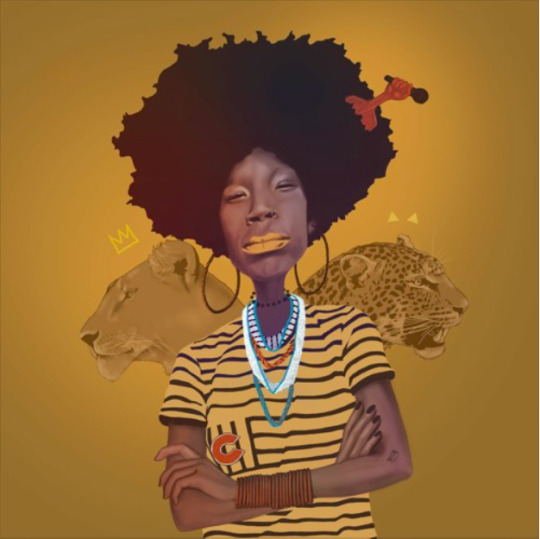
VWETO III cover art by Breeze Yoko
SILY: How did the songs on here with vocals come together, whether the ones with your singing or the ones with featured artists? Did the words or beats/melodies come first?
GAM: The beats came first except for “Shana’s Back”. Shana Jensen is my sister; she’s the mother of my niece. Every time she’d come over and I had an idea to compose songs around her, they’d end up being huge songs. She’d be like, “Bye!” [laughs] I guess she wanted something a little more understated. I’d always end up doing big Motown sounds. There’s a song on The Blackhouse called “Shana’s Groove”. It’s a like a reoccurring situation and character. It’s kind of funny at this point.
The other ones, like “Unforgettable”, I’m very much matching the vibe, the punk-funk aesthetic. Sometimes a little hook just pushes it over the edge and gets them into the mindset I was in when thinking about it. Other songs like “Love Call” I just wanted to sound like it was in an arena. Arena rock, funk, Digital Underground-inspired, all the way.
SILY: Are you a big Digital Underground fan?
GAM: I think it shows in a lot of the music I make. I don’t think I can hide it. This record has so many examples of that. I love Shock G so much. He was so bad, as a thinker, a philosopher, a community builder, artist, pianist, maestro. The “Love Call” groove, “Unforgettable”, “[Old] Jack Swing”, you can hear it. I was raised with that kind of music in my head as a child. Unashamed to be funky and make a groove have extra grease on it. That’s what distinguished our sound from other region’s sounds. Getting greasy. While still doing the boom bap and all that other stuff. For me, it was always a goal to represent where I’m from in my music in a non-traditional way. Bringing what I love about the West Coast to whatever I was working on.
Shock G lives in all of us. He brought so many different vibes. A rhythmic pocket that breathes. Somewhat right under "Atomic Dog”. It keeps you moving. It has a breath of life in it. I’m so thankful to have lived in an era where I could hear and experience his work.
SILY: How did “Ayun Vegas” come together?
GAM: Ayun is my little brother. I think I’ve known him since 2014 or ‘15. He’s quite a talent. I love his style. He’s from [New] Jersey. I love his sense of rhythmic dynamic. His use of metaphor, double entendre. I feel like he’s really a gifted poet. He can do all types of different things. He’s an amazing MC--he just released a project with Jacob Rochester called Slaps & Hugs. I’m gonna lean towards people who are creative themselves and insert themselves into everything they do.
Ayun is very secure in being different. He came out to Vegas, and I had this song. Usually, when I play leftfield stuff, MCs want that beat they can crush and not feel challenged by. This song is really old. I feel like it was made in 2016. I feel like that was the first time when somebody was willing to rap on an idea that was out of the ordinary. It’s not just in your face. It’s something different, but I want you to rap for your life on this. Something more like a movie score, where you find your character. He did it! He didn’t leave one beat behind.
He’s rhythmically gifted and quite the poet. He almost went into pro football but he chose music. He’s a very enterprising brother, doing all types of apparel. He was working in the visual artist community, in the videographer community. Any time I can showcase what it is that he got to share, I’m there. He’s not afraid to speak the truth. This verse is impressionistic. It’s like somebody is taking a really big brush and making a beautiful image, strong-arming it. It’s dope. I love it.
We did another song together on the Overload album, but it didn’t make the cut. The Japanese version of Overload has a song called “What Can We Do Now”, and it has Ambrose Akinmusire, Ayun, and me. I’d love for that to be heard stateside, because it’s definitely about what’s happening over here.
SILY: Why did you choose to have the proceeds for this record go to Critical Resistance?
GAM: I’ve always wanted my music to be a tool for the motion of people. It doesn’t stop with dance and rapping and singing and drawing. It begins with that. Where it ends up, the movement of people coming into their powers, truths that in order to have a more humane society, we are going to have to throw some of this bullshit away. The spoils of enslavement. We’ve got to get rid of those spoils so we can get to a more realistic place of folks being cognizant of the activities that they take a part in. Jails ain’t gonna help people feel like they’re part of the community. They cage people and endanger their lives and run the risk of ruining somebody’s mental, emotional, and spiritual state even if they did commit the crime they’re in there for.
There’s a sense that all crime is committed from a place of fear. Many crimes people are locked up for is just folks trying to find a way. I don’t see how more fear is going to rehabilitate. The idea that punishment leads to enlightenment. People in the public school system are taught about some of the baddest people that ever lived--mass murders. But they’re not the type of people held accountable. They’re who brought over the imprisonment systems from their failed nations.
I don’t believe in reform at all. Critical Resistance seeks to abolish prisons as we know them. I love that their resolve is so sure and bold.
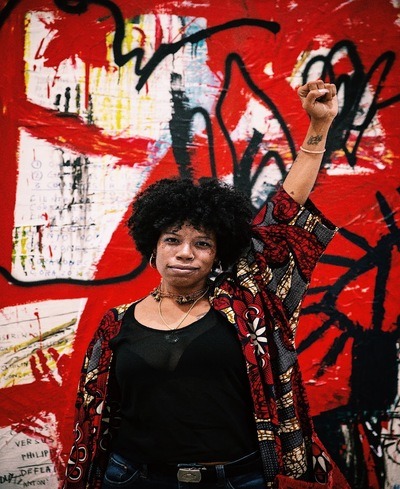
Photo by Antoinette A. Brock
#interviews#georgia anne muldrow#breeze yoko#critical resistance#pitchfork music festival#vweto iii#Antoinette A. Brock#FORESEEN#Epistrophik Peach Sound#Mama You Can Bet!#jyoti#dudley perkins#vweto ii#overload#live picks#instagram#mufaro's beautiful daughters#teacherie#digital underground#bandcamp#bandcamp live#shana jensen#the blackhouse#shock g#ayun bassa#jacob rochester#slaps & hugs#ambrose akinmusire#g-funk#boom bap
7 notes
·
View notes
Text
How intense psychotherapy and a Bel-Air love nest led to John Lennon's classic debut album
New Post has been published on https://depression-md.com/how-intense-psychotherapy-and-a-bel-air-love-nest-led-to-john-lennons-classic-debut-album/
How intense psychotherapy and a Bel-Air love nest led to John Lennon's classic debut album

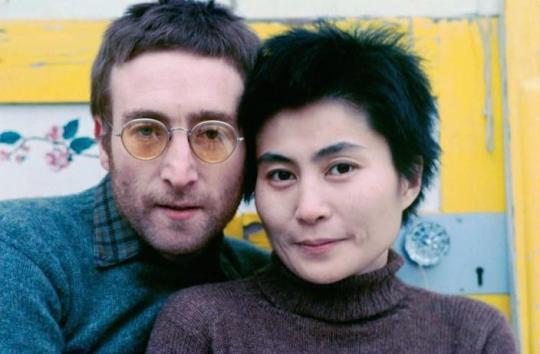
John Lennon and Yoko Ono in January 1970. (Richard DiLello / Yoko Ono Lennon)
In the months before John Lennon and Yoko Ono entered Abbey Road Studios in London to start work on what would become the album “John Lennon/Plastic Ono Band,” the couple were renting a home on Nimes Road in one of L.A.’s fanciest neighborhoods, Bel-Air.
The Beatles were still the most famous group in the world but were in the midst of breaking up, with members traveling to and from London to finish “Abbey Road,” work on various solo projects for their label Apple Records and argue about release schedules and royalties.
Living along a curvy lane behind walls that afforded complete privacy and overwhelming views of the city, Lennon and Ono were a world away from that drama. They woke to the sounds of chirping birds, sprinklers and lawnmowers, enjoyed their tea alone and, when so inclined, chilled by the pool. Lennon worked on some songs, including “Working Class Hero,” “Mother,” “Well, Well, Well” and “God.”
Then, each morning, Lennon would drive down Beverly Glen to psychologist Arthur Janov’s West Hollywood office, enter a darkened, soundproof room and scream as loudly and violently as he could.
“He used to finish a session feeling incredibly good,” Janov once recalled.
This backdrop set the tone for “John Lennon/Plastic Ono Band,” which came out in December 1970 and is the subject of an exhaustively documented box set just released by Capitol/UME and the Lennon estate. Called “John Lennon/Plastic Ono Band (The Ultimate Collection),” it comes with six CDs, two Blu-ray discs, a hardbound book, poster and postcards. It’s a revelatory set, especially for those with access to hi-fi gear and a darkened, soundproof room.
Newly mixed to increase Lennon’s vocal presence from fresh high-resolution transfers, the set features 87 recordings that have never been officially released, including rehearsal sessions, demo tapes recorded on Nimes Road and a series of alternative mixes drawn from unused tracks — congas on “Hold On” are a revelation, for example. An accompanying coffee table book, “John & Yoko/Plastic Ono Band,” offers an even deeper dive into the couple’s creative partnership.
Story continues
“During 1970, we did extensive Primal Scream therapy for six months, which was very beneficial for us and many of the songs were inspired as a result of those sessions,” writes Ono in the preface to the coffee table book, adding that “John’s songs were a literate expression of his feelings.” (Ono declined an interview request for this article.)


John Lennon relaxing by the swimming pool at his and Yoko Ono’s rented home in Bel-Air during the summer of 1970. (Yoko Ono Lennon)
The result, “John Lennon/Plastic Ono Band,” was Lennon’s debut solo album. It was issued the same day as Ono’s companion album, “Yoko Ono/Plastic Ono Band,” and found Lennon in an intimate setting with a few friends purging unfiltered emotions into songs about “freaks on the phone,” isolation, leaders who “tortured and scared you for 20-odd years” and his lack of belief in, among concepts, Jesus, magic, Adolf Hitler, the I Ching, the Buddha, yoga, kings and the Beatles.
“He had changed a hell of a lot because of this primal scream thing, and that was really heavy,” says Klaus Voormann, who played bass on the album, on the phone from Germany. “It was heavy for him, it was heavy for Yoko, and it was heavy for us.”
As with most things Beatle-related, the critics loved Lennon’s “Plastic Ono Band” when it came out. Creem’s Dave Marsh wrote that it was “interesting and even enlightening to see a man working out his trauma on black plastic but more than that, it’s totally enthralling to see that Lennon has once again unified, to some degree, his life and his music into a truly whole statement.”
The Times’ Robert Hilburn called it “nothing short of a masterpiece,” and “a work that is filled with pain and sorrow, searching and struggle. It is frightfully honest, profoundly moving.” That its emotion is tied to a bestselling psychology self-help book is often overlooked, but it played a central role in Hilburn’s review.


Arthur Janov in 1998. (Ann Summa/Getty Images)
“Primal therapy has to do with the traumas you’ve undergone in the womb, at birth, in infancy and childhood,” Janov explained in an interview excerpted in the book. “We have needs that we are all born with, and when those basic needs are not met, we hurt. And when that hurt is big enough, it’s imprinted in the system. It changes our whole physiologic system and all those pains are held in storage, causing tension, anxiety and depression.”
After Lennon and Ono read Janov’s book, “The Primal Scream” (subtitled “Primal Therapy: The Cure for Neurosis”), Ono asked that Janov travel to them in London, which he did. “He was in bad shape. He couldn’t leave his room,” Janov said of Lennon. But Janov had work in L.A., so Lennon and Ono followed him back and rented a home in Bel-Air. Lennon wasn’t the only one enduring pain. He and Ono had been trying to have a baby, but she had suffered two miscarriages.
Forced to return to England six months later to deal with visa issues, Lennon and Ono were barely off the plane before they entered Abbey Road. The sparse, emotionally raw Lennon solo album is dense with echoes of his West Hollywood wails, and the sessions were the same, Voormann says.
Voormann, best known for creating the art for “Revolver,” had met Lennon and the rest of the Beatles long before Beatlemania took hold, when they were rocking the Star Club in Hamburg, Germany, in the early 1960s, and he remained within the band’s inner circle. At the end of the decade, Voormann had just concluded a run with Manfred Mann when Lennon called to ask whether he’d join him, Ono, Ringo Starr and producer Phil Spector at Abbey Road. Needless to say, it was a welcome invitation.
At Abbey Road, Voormann described walking into “a whole vibe. There was crying. There was laughing. There was happiness. There was hugging each other. And we were all part of this amazing atmosphere.”


John Lennon at EMI Studios in London on Oct. 9, 1970. (Yoko Ono Lennon)
Simon Hilton, the box set’s producer and production manager, said that contrary to reports that Lennon “was angry and throwing headphones and stuff and making a fuss” during the week at Abbey Road, “there’s no evidence of that at all.”
Listening to the rehearsal tapes, which find Lennon, Starr and Voormann working through classics including “Honey Don’t,” “Mystery Train,” “Glad All Over” and the Beatles’ “Get Back,” Hilton continues, “you can hear what an amazing time they were having.”
The three were “obviously working really hard but also really enjoying being in each other’s presence. They were such good mates and I’m sure after the tensions of sitting in the room with Paul and George and Ringo, this was a huge relief.” (Hilton stresses that “John never had any beef with Ringo, ever.”)
“There is a playfulness among the three main musicians that in no way represents how earnest the songs are,” says Rob Stevens, who worked as a mixing engineer on “The Ultimate Collection” and oversaw the raw studio mix recordings and outtakes. “The laser beam is turned on right when the take starts and it’s turned off at the end — and there’s some real silliness before and afterwards.”


A Klaus Voormann illustration from the “John Lennon / Plastic Ono Band” sessions in October 1970. (Klaus Voormann)
All you need to do is listen to “Mother,” the wrenching opening song on the album, to appreciate the ways in which primal scream therapy informed the sessions.
Voormann remembers worrying about Lennon’s vocal cords as he sung the track’s climactic ending, which finds the singer pushing his limits. “I was thinking, ‘Oh my God, I hope he’s not going to lose his voice.'” Lennon, the bassist adds, was never trained as a singer, and cited as an example once requesting “Please Mr. Postman” during the Hamburg days. Lennon declined. “He said, ‘No, let’s do it as the last number because if I do that now, I’m going to be hoarse all night.'”
Lennon is on the cusp of hoarseness, Voormann says, in the final version of “Mother,” which is a song that addresses Lennon’s relationship with his mom, Julia, who as a young parent left Lennon to live with his Aunt Mimi and only sporadically reached out after that. (“I lost her twice,” Lennon recalled during an interview. “Once as a 5-year-old when I was moved in with my aunty, and once again when she actually physically died.”)
“His voice is already starting to break on the record,” Voormann says, “and it’s fantastic because he is really screaming as much and as long as he can. He wanted to get that out of his system. The wounds were opened up inside of him, and these wounds he put into those songs.”
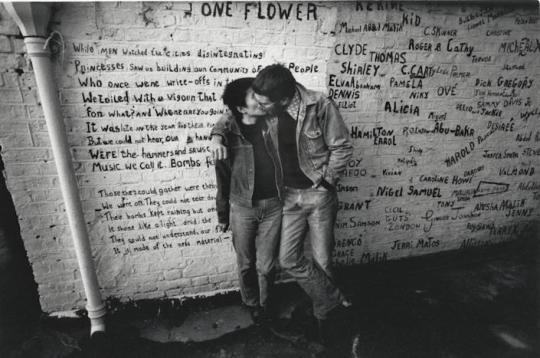

John Lennon and Yoko Ono in London on Feb. 11, 1970. (Richard DiLello / Yoko Ono Lennon)
If there was a flaw, for Ono it was in the final mix. Lennon’s voice wasn’t prominent enough. For this new remaster, Ono suggested the engineers make it more prominent. “That was Yoko’s directive right from the beginning,” says Paul Hicks, who mixed and engineered much of the new set. “‘Bring John’s voice out to the fore’ and ‘You’ll find all the emotion in John’s voice.'”
Adds Rob Stevens of Lennon and Ono’s Lenono Archives, “Bringing John’s voice up was a real revelation for just about anybody who had listened to anything else that he had done.” Referring to a microphone effect that adds a sharp echo, Stevens added that Lennon “covered his voice up with a ton of slap. There’s a ton of reverb.” Stevens says that in the process of working on the recordings, he was able to remove the reverb and hear the unfiltered Lennon. “What was there was the same emotion but more nuanced because there wasn’t a slap or two or three behind it.”
The producer and engineer John Leckie was 20 when he landed a coveted entry-level job running tape at Abbey Road Studios in London. He started in January 1970 and, not long after, was in the studio recording “All Things Must Pass” with George Harrison, and half a year later he was working on Lennon’s record.
Leckie, who has gone on to produce essential records by the Fall, Radiohead, XTC, Elastica, My Morning Jacket and dozens more, says that he recalls this early Lennon session as being a relaxed, comfortable environment. Spector was a quiet, unobtrusive presence — there was no “Wall of Sound” at Abbey Road — and Ono was more involved with the creative back and forth.
“Phil wasn’t there all the time, but my memory is that he was there a lot of time and when he was there, it was really good vibes. It’s funny, because when people ask me about this record, they always seem to think there was this angst — dreadful, painful. ‘What was it like to be in the room with John pouring out all this angst about his abuse over the years and the terrible terror he was going through?'”
Leckie continues, “It wasn’t like that at all, and you can tell by this box and the outtakes it was great fun. He was playing with his best friends. He was playing with Ringo and Klaus Voormann, and he’d known Klaus since Hamburg.”
Voormann underscores the sense of camaraderie at play, an experience jarred by hearing the rehearsal tapes anew. “All this came back to me. It felt so good having certainty knowing we were really a group — this little tiny group, just Ringo, me and John.”
Lennon’s solo debut, in hindsight, was an outlier. He started recording its follow-up, “Imagine,” less than a year later, and not long after that, he and Ono separated. Lennon moved back to L.A. and commenced a bender that many nights led him just a block from Janov’s office, getting drunk with Harry Nilsson at the Troubadour. Lennon and Ono reconciled a few years later. The five studio albums that followed “Plastic Ono Band,” while accomplished, seldom matched the feral energy and sharpened pen found on his debut.
Meanwhile, by 1974, Janov was in the pages of The Times being lumped in with Dear Abby, Billy Graham, radio talk show hosts and witches, as a guru who “professes to have an answer for sale.” A documentary called “Primal Process” followed a few years later. One reviewer praised the film but warned that “the continuous crying can be taxing.” In the 1980s, the English new wave group Tears for Fears took its name from Janov’s therapeutic method, and the similarly inspired “Shout” became one of its signature hits.
Janov, for the record, loved “John Lennon/Plastic Ono Band.” Speaking to Hilburn in 1970, the therapist and author, who died in 2017, described it as “a very dialectic album. It is the most personal statement imaginable, yet it has a universal language. It could only be written by someone who has arrived at a state of understanding himself. It isn’t something that any kid with a guitar could sit down and write.”
This story originally appeared in Los Angeles Times.
Source link
5 notes
·
View notes
Text
idk
I know I’m getting aggressively upset by the amount of criticism I see and it’s not healthy for me to engage with it, even in these little rants I’m posting, but the reason I’m so frustrated is because I entered this fandom with a lot of love and joy in my heart
really long post below the cut about my history as a fan of the gorillaz and why song machine is perhaps my favorite “phase.” I just want to talk about the things that are important to me and make me happy...
my introduction to the gorillaz was the feel good inc video. I was over at a friend’s house and she wanted to show me something really cool on the internet (I was so impressed she was allowed on the computer AND without any supervision). I was 8 or 9 years old and I didn’t know what a music video was, that’s right, feel good inc. was the first music video I had EVER seen.
needless to say, it absolutely blew my mind. it’s a fucking iconic song AND iconic video. I didn’t really comprehend what I was looking at, I didn’t know these were characters with backgrounds, and I don’t even think I realized that the song was like. a song from a band. I just thought it was some kind of short film, a self-contained story. my idea of that video was completely divorced from what the gorillaz actually are, and to this day it still kind of is. I love that. it’s special to me for that reason, it feels like. like it’s mine.
I didn’t really listen to music that wasn’t what my friends or parents like, and the first time I had music I could sort of call my own was when my sister moved out and left all of her CDs with me. it was all stuff she HAD liked but wasn’t really interested in anymore, and a lot of it was stuff that I got to hear on my own, by myself, an experience I didn’t have to share.
some of the music still closest to my heart came from that CD case, it’s where I discovered the killers and death cab for cutie, which I have always considered my favorites. for whatever reason, until recently, I hadn’t really considered the gorillaz were included in that, but that’s how I was first PROPERLY introduced to the music: demon days.
I remember listening to that album, alone on my bedroom floor, completely entranced by sounds like I had never heard before. once again, it was divorced from the context of the gorillaz as a virtual, socially-critical band. all I knew was the music. all I knew was the sound. and I of course recognized feel good inc, but I didn’t really remember the video or where I knew the song from, I had suppressed most of the memories from that time in my life. and so that song existed as an impression of a memory, haunting my mind and connecting me to something I couldn’t quite put a finger on.
I had my own private version of demon days in my head. a loose series of images and colors and a sense of some kind of narrative based on what little I could understand of the lyrics. it had nothing to do with the characters, in fact I didn’t even know they existed. once again, that album still somehow feels separate from the way I’m experiencing the gorillaz now. and i like that. I need that to never change. it feel like it’s mine.
I’ve never cared about who makes the music I listen to (and I understand now that sometimes that’s a problem). I don’t know why but I never bothered looking up music videos for songs I liked, sometimes a friend would show me something or I’d be listening to music on youtube and happen across a video, but even then I preferred lyrics videos. I never looked up artist names, lead singers, band members, history of the bands... in fact I usually didn’t even look beyond the albums I already liked. this is how I managed to remain ignorant of the gorillaz and didn’t listen to any of their stuff beyond demon days until highschool.
that’s when I met my who is now my best friend. she was a REAL gorillaz fan. she listened to ALL of their music and watched ALL of their videos and knew the “lore”... when we first started talking about the gorillaz I suddenly found myself way out of my depth. when we watched the feel good inc video (which I’m pretty sure I hadn’t seen it since that first time) she had to explain to me that no, those characters, THAT’S the band. and I was like, um what the fuck? as embarrassing as it is to admit, I thought that de la soul were the band because those were the REAL people in the video ^^”’
I still didn’t have a lot of context for what I was seeing in the plastic beach videos, but of course I liked the music and the videos were super fun! because of my friend, I would hear gorillaz songs fairly regularly, though I never really sought them out myself, which is why I never listened to plastic beach, humanz, or the now now as actual ALBUMS. all I knew from them were the handful of videos that my friend would show me.
to illustrate just how clueless I was despite all of this: we got the power played frequently on the radio during my last year of college. I found it inspiring and loved singing to it, always meaning to look up who it was by, but by the time i’d be done driving I’d always forget to. I literally had no idea it was a gorillaz song. in fact, the same thing happened with momentary bliss earlier this year.
so how did I end up here? how did I suddenly have a huge interest in the band in its entirety, listening to the albums AND falling in love with the characters?
well, song machine happened. désolé happened.
the song, the video, it felt like perfection. the vocals made a home in my heart, and fatoumata diawara is such a gorgeous, delightful person... and so my friend kind of just shared stuff more frequently with me.
désolé made me fall in love with the new music, but my attempts to love my changing body are what led me to an interest in the characters.
long story short, I started T wand was worried about becoming one of those guys that is skinny but out of shape, small butt and a bit of tummy. I was so self conscious but when watching the strobelite video I thought 2D had a body type that was a stylization of what I was going to end up with. it made me feel so much better about myself and so I thought it’d be great to cosplay him and since I was going to cosplay him, I thought it was about time to learn the backstories of these characters... I was wholly unprepared for just how much interesting content there was.
I had no idea the amount of depth there was! I really was discovering the whole other half of the gorillaz, I went from no character content to more than I could have ever dreamed of.
and so I guess that’s why I have a completely different perspective than the other fans I’ve encountered. I understand why people who are used to having something great are so upset about the character side of things now... but in a lot of ways I’ve experienced the reverse. I went from nothing to a whole world of stuff to explore. it’s fantastic! it’s exciting!
and it’s why I’m so easily pleased with the stuff coming out now.
I entered this fandom with the joy of discovery, with the desire to explore, with the love of the current phase because it’s coincided with my introduction to the characters and thus is special to me just like my introduction to the music was special.
and damn is it not heartbreaking to go into something happy and find that much of the discussion around this thing that you love is about how much other people hate it.
#sigh...#the long and the short is that i have a hard time relating to other fans#the feel when you actually adore the current phase#i'm usually pretty good about curating my online engagement with fandom in a way that allows me to just focus on what i like#but it's like every single gorillaz blog i try and follow is so negative that i just can't get away from it#personal shit#still not tagging this even though i really wish i could share#it's lonely here#damn this is long#sounds#music
11 notes
·
View notes
Text
Okay so I just happened to be working on two playlists that had nothing to do with each other but coincidentally their common aesthetic was “unhinged“. And then suddenly, at a moment’s notice, a god more ancient than pagan beamed an understanding into my brain in a matter of something like 10 seconds and my third eye just opened so wide that it fell right out of my skull. NONE of you are ready for the forbidden knowledge that I’m about to unleash
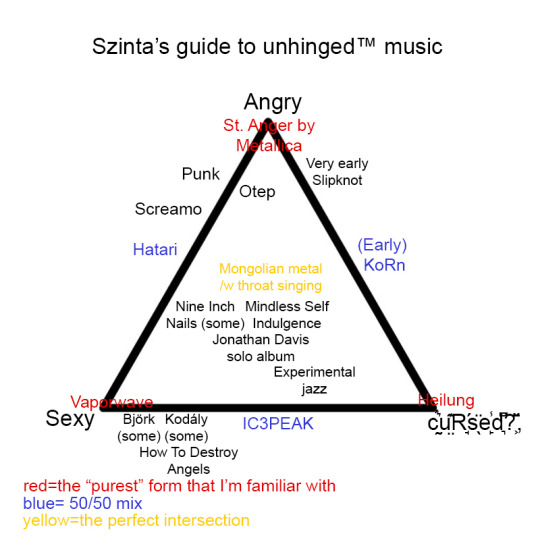
I would like to point out that a). what one’s definition of “unhinged“ is, is a personal metric that is not only very subjective but doesn’t need to be made objective, and b). the names are just meant to be taken as examples, they are obviously limited to music that I could think of off the top of my head, and c). regardless of a) and b) the spectrum itself in essence is still factually accurate and transcends musical genres or personal tastes
Why yes, thank you for asking, I actually DO have a playlist with examples to illustrate my point, MOREOVER even working on an extended edition of the playlist where I welcome your recommendations of music that you consider to be unhinged.
A little bit more wordy explanation of my playlist under the cut.
First, the purest forms:
St. Anger by Metallica (I meant the whole album, but the titular song is as good as any) a good example of Vaporwave that I could find Elddansurin by Heilung (pretty much anything from Heilung, but this particular song is both short enough to prove the point succinctly and fucks)
I don’t have a lot to say about these, listen into them for a few seconds and you will get a good idea what each tip of the triangle really means.
The 50/50 forms:
Sexy + angry: Engin Miskunn [No Mercy] by Hatari Their perfectly balanced nature is heightened by the complementary duality of their vocals - Hatari is like a two-headed monster whose one head is trying to seduce you and the other is very, very angry. Though, that can also be seductive in it’s own way, if that’s your thing, I’m not judging. Hatari would certainly agree from what I would know. Their entire oeuvre is kinda like this, so here’s a fresh and sexy sexy song by them that, indeed, mercilessly slaps.
Angry + c̵͓̗̿͘u̶͈̾̍R̸̪̔͠s̸̖͙̀e̶̺͖̓d̴̦͂̎?̶̥͂͋ͅ,̷̟̀,: Good God by KoRn KoRn has always been famous for doing their extremely unhinged own thing, especially in their early days. This is not even their most unhinged song from the album that this song comes from, but i felt like this is a good intersection between accessible + illustrating the point.
Sexy + c̵͓̗̿͘u̶͈̾̍R̸̪̔͠s̸̖͙̀e̶̺͖̓d̴̦͂̎?̶̥͂͋ͅ,̷̟̀,: Грустная Сука [Sad Bitch] by IC3PEAK If you don’t know them already, allow me to introduce you to absolute embodiment of Feral Big Dick Energy music of IC3PEAK. This is their most famous banger but literally everything that they make sounds like this.
Perfectly balanced, master of the three elements, the avatar themselves:
Blue Mark by Altan Urag Exactly what it says on the tin tbh. I want to add that technically any combination of modern music genre + leaning into a folk music aspect in a feral way + strange vocalizations/instruments could fit this bill, but there is something specifically about Mongolian metal that makes me instantly regress into the genetic memory of an 1200 year old ancestor who was still backwards-riding a horse on the Eurasian steppes as a nomad warrior. So here’s a little Altan Urag. If you think Apocalyptica is cool, you will like this A LOT.
Mixed forms:
Crucify Me feat. Lights by Bring Me The Horizon 60% angry, 40% sexy I had to ask for the expertise of my sister on this, who literally grew up on screamo. Based on my limited experience, I think the cursed aesthetic is missing from this genre entirely by definition, though there might be some variation to that.
Holidays In The Sun by Sex Pistols 85% angry, 15% sexy The spiritual great-uncle of screamo, this genre is an almost pure manifestation of angry unhinged, but as opposed to early Slipknot, with more of a slight sexy streak.
Human Behaviour by Björk 90% sexy, 10% c̵͓̗̿͘u̶͈̾̍R̸̪̔͠s̸̖͙̀e̶̺͖̓d̴̦͂̎?̶̥͂͋ͅ,̷̟̀ For me personally, Björk plucks the blurred line between “normal“ and “unhinged“ like the string of a harp, just being a tiny little bit off-kilter enough to be categorized as such, which in itself ads an uncanny aura to her otherwise whimsical music.
Székely keserves [Transylvanian Lament] by Kodály Zoltán 80% sexy, 20% c̵͓̗̿͘u̶͈̾̍R̸̪̔͠s̸̖͙̀e̶̺͖̓d̴̦͂̎?̶̥͂͋ͅ,̷̟̀ Kodály is a Hungarian neoclassical composer. Not everything he wrote is like this, but he can lean into the cursedness surprisingly hard if the topic/emotion demands. Please enjoy his unhinged interpretation of a miserable folk song.
Very different genre, but same sexy to cursed ratio: Too late, all gone by How To Destroy Angels
I admit that I have zero idea who the big names are in contemporary jazz but I added the first thing that sounded similar enough to what I imagined in my head. Since fluidity and going off the rails is a big staple of jazz, I think the whole genre deserves the honor. Depending on song and performance I would rate it on average about 50+% sexy, ~30-40% cursed and up to ~15% angry.
What You Believe by Jonathan Davis 20% angry, 40% sexy, 40% c̵͓̗̿͘u̶͈̾̍R̸̪̔͠s̸̖͙̀e̶̺͖̓d̴̦͂̎?̶̥͂͋ͅ,̷̟̀ This is such an interesting example because the chorus is completely unironically normal but the verses inbetween are just so cursed in a peculiar way, making the song overall both extremely strange and SUPER catchy at the same time. To the point you’re almost feeling like you’re being somehow subliminally manipulated. Just don’t worry about it mate. Everything’s fine. It slaps.
Closer (Deviation) by Nine Inch Nails Not everything that they make would I consider unhinged, but Trent Reznor has a great flare to inject music with electronic effects that sound kinda bizarre, putting his work somewhere in the direction of ~30% angry, ~50% sexy and up to 20% cursed on average. I added the most unhinged song that I could think of, and possibly one of the most unhinged songs ever made. 50% sexy, 50% cursed and 120% gnawing on the walls levels of sexually frustrated. Very NSFW.
Bitches by Mindless Self Indulgence 30% angry, 30% sexy, 40% c̵͓̗̿͘u̶͈̾̍R̸̪̔͠s̸̖͙̀e̶̺͖̓d̴̦͂̎?̶̥͂͋ͅ,̷̟̀ MSI, within this spectrum at least, is almost exactly the same as Nine Inch Nails except that they are way more cursed leaning. They are also a pretty good illustration for the point that sexual topics and “sexy” unhinged as an aesthetic are two completely different things. NSFW.
Apex Predator by Otep 60% angry, 30% sexy, 10% c̵͓̗̿͘u̶͈̾̍R̸̪̔͠s̸̖͙̀e̶̺͖̓d̴̦͂̎?̶̥͂͋ͅ,̷̟̀ I don’t have a lot to add about this, but if you wanna hear a truly unhinged woman lead a band, then you’re going to have a field day with Otep. Enjoy to your heart’s content.
My Plague by Slipknot 85% angry, 15% c̵͓̗̿͘u̶͈̾̍R̸̪̔͠s̸̖͙̀e̶̺͖̓d̴̦͂̎?̶̥͂͋ͅ,̷̟̀ When Slipknot first entered the scene, I heard a lot of metalheads turn their noses up at their work for not being “heavy enough(?)“ whatever that even means, but I think that their earliest stuff is bravely unhinged in a way that seems entirely unique to them. Kinda like the sloppiest, dirtiest of punk, but in an intentionally unappealing, even disgusting manner. Early Slipknot shamelessly embraces the filth and that earns my respect, in a way (their later stuff unfortunately lost this quality but they still write good songs, I think?) You could listen to literally anything from their first album Iowa to get my point but to be seasonaI, I added a #quarantine mood to the playlist.
So that would conclude my introductory 101 tedward talk about unhinged music that literally nobody asked for but hopefully got you acquainted with some new music and/or ideas that you have never heard before!
#literally DO NOT ask me questions about music because i will IMMEDIATELY manifest into the conspiracy theory guy from always sunny#music#shamansongs#sithi's posts#text#the nine long nights#sithi reads
12 notes
·
View notes
Text
My review/thoughts on MOTS7!
This album blew me away in terms of the lyrics, sound composition, EVERYTHING in fact so I figured that I would write a little review of it! Listening to every past BTS album brings me acutely to a period of my life when it was first released so I’m curious to see what memories I’ll forever associate with MOTS7
Interlude: Shadow- From the moment the MV was dropped I was speechless by this masterpiece. It sets the tone for this album so incredibly well by setting up the parallels between fighting your shadows and being engulfed by them. This constant battle I feel is central to the album as a whole. The alternation between Yoongi’s whispered beginning of “I wanna be a rapstar” “I wanna be king” to the Agust D esque switch of flow at the end almost seems as though his shadow is talking back to him. It is as though he realises that he cannot escape it but must embrace it to emerge from it. And also his INSANE flow and fluidity of rap is just something else, this song was made for Suga.
Black Swan- This has got to be one of my favourite songs from the album, I was hooked by the dark, almost classical intrumentals paired with the urgency of the vocals and rap. I feel as though this is one of the most introspective songs the boys have ever written, with the analogy of the dancer’s first death working to illustrate how art is all consuming for the creator. The pulsing beat underneath the vocals and rap served as a reminder of how important it is for artists to have something that literally makes their heart beat. It’s rare when songs make you truly analyse not only the lyrics but your relation to them and Black Swan 100% did that for me.
Filter- This had me HOOKED from the first few strings and the smooth Latin beat made me imagine listening to this whist walking through a bustling city at sunset. Jimin’s vocal range and siren like vocals make this song alluring and addictive in a way that no other singer could have done. The lyrics are playful and confident yet simultaneously deep. Jimin realises how attractive his various sides are to millions around the world and he owns that, yet he’s also aware that what people see is mostly akin to a filter, not reality in itself.
My Time- I’m so proud of Jungkook for experimenting and creating different sounds for each of his solo tracks and My Time is no exception. His beautiful airy vocals echo and blend perfectly with the lowkey beat. The lyrics hit hard when you realise that Jungkook’ s time scale of life has been directly opposite to that of his peers. He’s grown up on airplanes while they took the subway and you get a sense of yearning from his voice, a yearning for maybe the childhood and things he missed out on. Yet there’s a sense of assertion, that he owns his time has been different and accepts his fate.
Louder than bombs- I 100% understand why Namjoon cried writing this song. It so perfectly encapsulates the sense of fear and desperation that arises from uncertainty in one’s position in life. Troye did such a great job helping the boys with this song because it sounds sonically like the pair of them together. Even though this song is one of the darker numbers on the album it is offset by the small hints of hope. Namjoon’s mantra that he’s going to “pray for better days” is so striking because often in life that’s all you can do when you’re breaking- hope that things will change and the majority of the time they do, so you need to keep that fire of hope alive in you.
ON- On is a certified bop and its so INTENSE with the drum beats in the beginning. This song is going to be amazing in concerts with its anthemic rhythm and the lyrics “bring the pain on” and “can’t hold me down cos I’m a fighter” are so empowering. I feel this song embraces the pain and hardship with the confidence of the rap and vocals coming together to say- bad things will happen but we’ll emerge stronger and surge ON.
UGH!- Even from the title I could tell that this queen was going to sit with her sisters Ddaeng and Cypher. I’m so incredibly proud of our rapline they SNAPPED, like the flow, the wordplay the artistry?? The gunshots immediately grabbed my attention and the build up the chorus which hits like a gut punch is EVERYTHING. The way they discuss anger is so pertinent, with the rise of social media people unleash their anger on whoever they choose whilst hiding behind a screen on anonymity. Anger, like they say, is necessary but only when it can be used as a motivator for justice. Petty cowardly anger, like that which is directed towards BTS, can only lead to pain and that is what our rapline so masterfully condemns.
Zero O Clock- This is my new healing song, the acoustic guitar and soothing vocals are like a warm hug. The chorus is so uplifting and assuring, just hearing the gentle refrain of “and you’re gonna be happy” is so comforting. This reminds me of curling up on a winter’s day and finding comfort in small things and happy memories regardless of the storm that rages outside. The way that BTS never tell you meaningless words like “don’t be sad”, instead they assure you that sadness will not last forever and that the metaphorical spring will brighten your life once more.
Inner Child- Tae’s solo track radiates innocence and I am so in love with it. The way that he accepts his past and the hard times he went through and instead of allowing himself to dwell on it, he looks to the future. The refrain “we gon change” is going to be so uplifting at concerts. Even though our boys bring us so much joy we have to remember they’ve been through so many trials in the past. It’s comforting to know that I’ve gone through struggles alongside him and we can both move on whilst still recognising that our scars are the reason we are here now and that they prove we are alive and capable of healing.
Friends- One of my favourites from this album hands down. This makes me so inexplicably happy. It reminds of walking home hands intertwined with your best friend after school, late night conversations and inside jokes that make you double over whilst still containing that deep and powerful love you share with your soulmate alone. And isn’t that just vmin encapsulated? I can’t wait to see they perform this live, the Stay! Hey! part makes me so nostalgic and makes me want to reassure them that they’ll always have each other and the cheers of us, their ARMY. The part where they acknowledge their relationship as soulmates made me BAWL, their bond is one of such purity and rarity and I’m honoured to even witness it.
Moon- Another one of my all time favourites from this album. This could be the soundtrack for a slice of life anime and it is so bright and cheery, like Jin himself. His sweet vocals and the beat fits the spring season so well and the lyrics made me so soft. The way he uses the metaphor of him being the moon and circling us, his precious earth made me realise even more how much his man ADORES us. How could anyone sleep on Jin?? He’s songwriting is so pure and his presence gives me such comfort and hope, you’re so much more than just a moon Jin. You’re our one and only moon.
Respect- Namgi you geniuses! The wordplay, playful banter and topic matter are so unique in this song that I knew that it could only be made for the two of them. Respect I feel at the foundation of all relationships, can you ever have a healthy and mutual relationship with anyone or thing if you don’t respect them? With their distinctive rap that blends and flows so well with each other Namgi discuss the concept of respect and what it really means in the modern world when people place a veneer over their actions and words so as to disguise whether or not they truly respect you. As artists all I feel Bangtan want is people to respect them, not idolise them, but respect their artistry and work and sadly in an world where people hold numerous prejudices this is hard. Kudos to them for exploring this topic in a way that is simultaneously light with the satori at the end but still very thought provoking.
We are Bulletproof: The Eternal- I was 100% expecting this song to be a hardcore hip hop track so imagine my surprise to find a song that made its way into my BTS songs I can’t listen to casually because they mean too much to me and will make me bawl in public tracklist. The gorgeously haunting melody, the angelic vocals and intensely emotional rap has me in tears. When they sing “We were only seven” and “But we have you all now” I lost it. The memories I have of BTS who were my second family for the majority of my youth, the times we spent together, the music that was the soundtrack to my life. The way they adore us and find comfort and hope from us... this song really made me believe that I’m going to love them forever and vice versa. It makes me less scared to go on the rollercoaster that is life knowing that I will always have Bangtan beside me.
Outro:Ego- I saw a post that said Namjoon looks up to his Persona, Yoongi’s Shadow looks down on him but Hobi is the only one who is at the same level as, and looks his Ego right in the eye. I feel this song is such a wonderful upbeat positive track that is so Hoseok?? The way that he accepts his fate and looks forward and is confident and happy in the person he is now? This is going to be amazing at all the summer concerts and it just radiates such joy and never fails to make me dance. The perfect ending to an album that chronicles the ups and downs of BTS’s relationship with their career and selves and ultimately ends on such a bright note of hope and happiness.
6 notes
·
View notes
Text
Basics Of Pop Music
Modern folks music refers to a wide variety of genres that emerged in the mid 20th century and afterwards which were associated with traditional folk music Beginning within the mid-twentieth century a brand new form of standard folks music evolved from conventional folks music. Large, like Salimpoor, says that this distinction in choice is because of how our neurons are wired together, which in flip is based on our personal, personal historical past of listening to or performing music. Rhythm is all about predictability, he says, and our predictions about music start forming from a reasonably early age onward. He factors to the work of Erin Hannon at the College of Nevada who discovered that babies as younger as eight months old already tune into the rhythms of the music from their very own cultural setting. Whether or not you agree with Stanley's personal opinions, his ardour is undeniable. When describing the music that has really moved him, be it a Seashore Boys tune, a Motown monitor, a punk anthem, a pioneering techno observe, www.magicaudiotools.com or a 70s bubblegum pop song, his eloquence and unabashed enthusiasm are infectious, drawing the reader in. Stanley is each professional critic and professional musician, but he's additionally at occasions merely a fan, desperate to share his discovery of pleasure with others. One may not agree with Stanley's private opinions, however any music fan is aware of the giddy rush that only comes when getting lost in a favorite tune. Regardless of your musical choice, that may be a universal feeling that this e book ultimately seeks to have fun, and in that it does a exceptional job. Musicians making the move from songs to cinema is a dodgy one which hasn't gone properly for some of her predecessors (Rihanna, I love you, but literally your entire films suck), but Gaga's funding in her debut lead efficiency is so sturdy that she's practically unrecognisable beneath it. That's not a gimmicky tackle her much-discussed ‘stripped again' look, it is a testimony to her skill as a sincere actor. She switches up all the pieces, from her conversational mannerisms to her distinct fashion of performing, to take us away from her personal pop narrative - even when Ally's story bares some glaring resemblances to her personal. Streaming companies are a beast that needs constant feeding. Youthful hip-hop artists, already accustomed to offering sites like SoundCloud with a relentless stream of mixtapes and features, have adjusted to its demands more quickly than artists from other genres, and have thrived accordingly. At the coronary heart of rap's streaming dominance is something extra ephemeral: Some songs simply stream better than others, for reasons that no one can really clarify but. Hip-hop streams higher than other forms of mainstream music, and trap music streams better than different varieties of hip-hop. However radio is certainly sputtering out. I myself only hearken to high-40 radio when I'm in a Lyft, and I am fascinated by how related every little thing sounds: same tinny manufacturing, same rap breaks, identical millennial whoop. Plus, playlists are narrower than ever, so the thought of radio as a discovery system is long gone. I assume children are discovering new issues through Spotify or Apple Music, whose algorithms and daily discovery playlists are scarily good at predicting what I am going to get pleasure from. Nonetheless, these things only collect information, and only reply with knowledge: more songs in the key of the songs you do not skip via, with the identical modulations and vocal model. We're all getting pushed deeper into our personal little corners. What you see before you is a list that I hope might be learn as an intervention. Almost 50 girls who play a task in NPR compiled and voted on this listing. It options albums by artists who determine as female — together with some by mixed-gender bands, like Fleetwood Mac and X, that, modern Pop Music in our view, relied on ladies's creativity for their spark. These albums have been released between 1964, the year The Beatles invaded America and set in motion what can be called the "classic album era," and 2016, when Beyoncé arguably ushered in a brand new period with her "visual album" Lemonade. The purpose is to offer a view of widespread music history with women's work on the center. The record does not represent an "alternate historical past." It stands for music historical past, touching upon every significant trend, social situation, set of sonic innovations, and new avenue for self-expression that in style music has intersected in the past fifty years. Though Schlager music is a part of the pop tradition, it occupies a special, considerably devisive area of interest; people are likely to either adore it or hate it. But then there's straightfoward pop music, usually viewed as more palatable and widely liked. A classic instance of this is singer Herbert Grönemeyer. Although many outside of Germany know him only from his function in the film Das Boot," he is also essentially the most successful artist in Germany, with a career that, to date, spans 44 years. It typically takes us the longest to stop punishing the merely good artists for not being geniuses, but ultimately we do — Hall & Oates just received into the Rock Hall of Fame , as an illustration, however a decade in the past folks were nonetheless snickering at their Nineteen Eighties blue-eyed soul-pop, little question in shame over having favored it for some time. I wonder if we will study to skip that center step? I've admired you for having the maturity to attend to the communal virtues of Mumford and Sons and other neo-folks bands I discover icky, for example. I think I dislike them partly as a result of I grew up with Nineteen Seventies Catholic folks-guitar lots, so such jangly uplift choral music strikes me as oppressively naïve. I am interested on this article not a lot for the specifics of the gear and the plugins, however fairly just out of sheer awe on the complexity and nuance of the monitor's soundscape. My cadre of pop-oriented music lecturers likes to say that the creativity in recordings lies not in their melodies and the chords essentially, but in their timbre and area. Call Me Perhaps" is an excellent working example. Its melody and chords are enjoyable, however not exactly groundbreaking. But the monitor leaps out of the audio system at you, demanding your consideration, managing both to pound you with sonic drive and intrigue you with quiet element. Whether you need your attention grabbed in this method is a matter of style. I occur to love the song, however even when it isn't your cup of tea, the craft behind it bears some desirous about.

The historical past of Popular Music hardly qualifies as a precise science. It is a retrospective analysis of events that focuses on the underlying forces or common signs in the overwhelming manufacturing of music data, ignoring nuances and aspect-effects to grasp a understandable construction. It is because (standard) music is much from a static phenomenon: it is a consistently evolving, reworking, large organism. Almost by no means has a music style suddenly emerged as a surprising revolution without any trace or evolution in the past. All of them have naturally developed, mutated, merged, or turn out to be (theoretically) extinct. Solely the previous could be examined of this pure, organic network.
1 note
·
View note
Photo
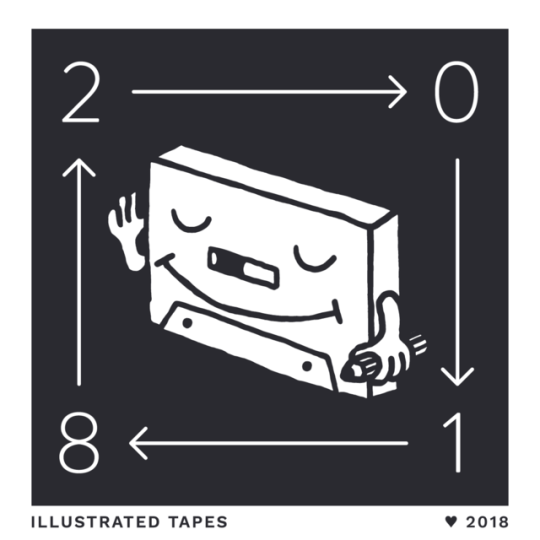
Welcome to Illustrated Tape’s favourite releases of 2018 that sounded and looked good, chosen by this year’s contributors. We’ve put together a playlist featuring one track from each of the releases featured so you can check out the sounds we were digging this year. Happy listening!
➔ spoti.fi/2LCgrQp Listening in order recommended
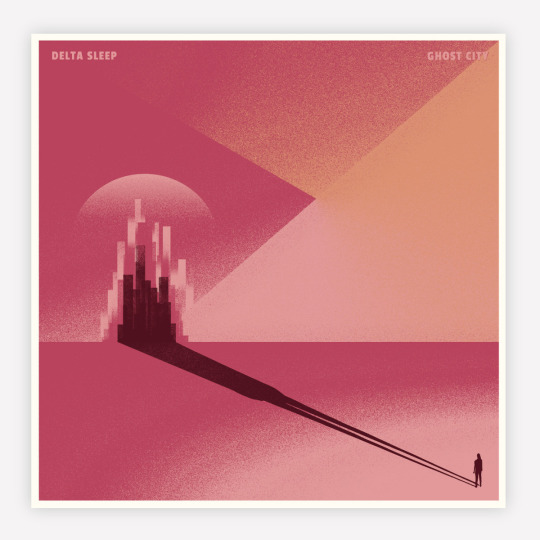
Delta Sleep - Ghost City Big Scary Monsters, 10 August Artwork: Owen Findley at Or8 Design Selected by Megan Reddi // IT014
This is my favourite music/artwork combo of 2018! The whole album is just amazing - it is beautifully arranged and has this lovely dreamy quality to it, with repeated musical motifs woven throughout to really pull the whole album together. Not only is Ghost City musically fantastic, but the artwork is beautiful and so fitting for the album. It is designed and screen printed by Owen Findley and the warm colours, imagery and textures are just spot on.
Definitely my favourite release of 2018. It is my go-to driving album and I will be blasting it while we’re driving around this Christmas!
➔ Listen to Illustrated Tapes 014: Nautical Dusk by Megan Reddi

Okay Kaya - Both Heavy Body, 1 June Artwork/design: Kaya Wilkins, Aaron Maine, Phillip Wong
Selected by Hannah Buckman // IT016
Okay Kaya’s Both as an album that came out this year which I enjoyed, and which I feel has a strong visual component to it. To me the album feels sickly (in a good way), gloomy but still pop. I think the mood is conveyed really well through the Adinah Dancyger directed music vids and the album art.
I liked finding out more about Kaya’s thinking behind the project, like how the twin in the videos is like a physical manifestation of trauma... it’s something that once I read I couldn’t stop thinking about. The idea of something traumatic inducing this birth of a second self, a kind of split off part that is still attached in some way to the whole, but there being a kind of safety in acknowledging what might be a darker part of yourself, from a distance. Also the album art kind of conveys the idea of duality and how that relates to race/sexuality, but I didn’t feel like that was really explored as much. I think I like this album ‘cos it kind of ties in with things (mentioned above) I’m currently interested in, but maybe it feels a bit surface-y at times.
➔ Listen to Illustrated Tapes 016: Protect Your Extremities by Hannah Buckman

Quavo - Quavo Huncho Capitol / Mowtown / Quality Control, 12 October Artwork: Mihailo Andic
Selected by Conner Perry // IT020
I think my favourite music/design combo of this year has to be Quavo’s Quavo Huncho. Not only is it full of bangers, the cover by Mihailo Andic is just brilliant. It really sets itself apart from the Migo’s visuals and changes the way you listen to the record. Definitely check out the rest of his work, especially the stuff for Lil’ Yachty.
➔ Listen to Illustrated Tapes 020: Nice one bruva by Conner Perry
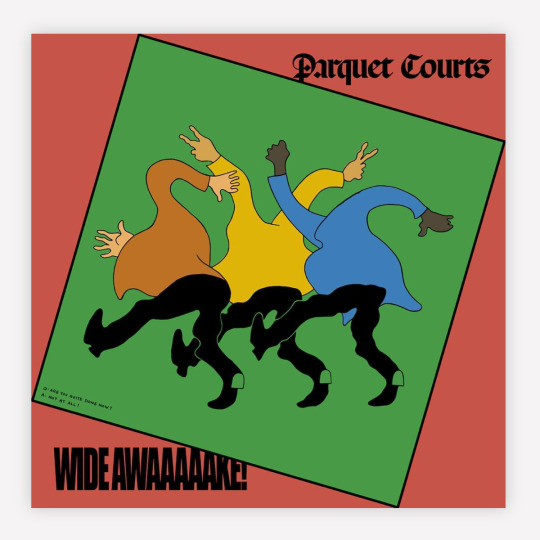
Parquet Courts - Wide Awake! Rough Trade, 18 May Artwork: A. Savage
Selected by Holly St Clair // IT021
I was really late to the Parquet Courts party, but actually both of my initial encounters with their two recent releases have been solid arguments for the importance of decent album artwork. For both Wide Awake! and Human Performance I ran into - literally - the artwork before the music. Twice, two years apart, whilst wandering around London I turned a corner and came face to face with Adam Savage’s superb cover work. He smacked me in the face with poppy colours and amorphous dancing forms and I loved every moment. Add in an anarchic use of type and you’ve got me shouting, “Oh shit! A new Parquet Courts album!” to no one in particular outside an old meat market in Shoreditch.
A. Savage is both front man and painter and that adds a special flavour to the whole affair. Album marketing can be a laboured, commercially driven affair, there’s something authentic - a little DIY flavour - about this relationship between artwork and music. It’s a nice parallel to the musical throwbacks typical of the bands style. Wide Awake! dropped earlier this year and it’s fab. (Although, I love the artwork so much even if it was god awful I’d still buy the record and hang it on my wall.)
➔ Listen to Illustrated Tapes 021: To: You, Love: Me by Holly St Clair
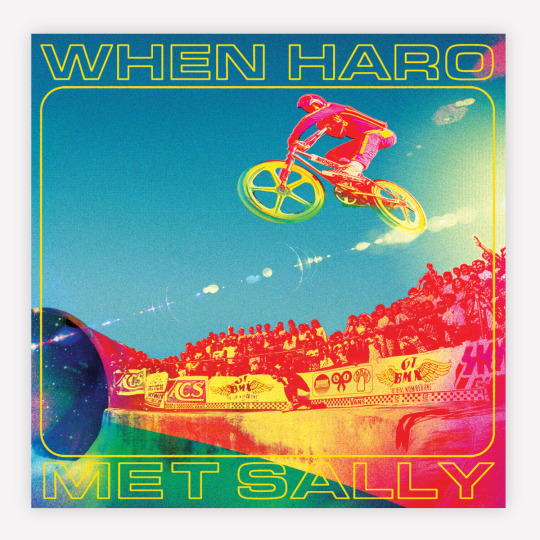
D.A.L.I - When Haro Met Sally Burning Witches, 23 May Artwork: Luke Insect
Selected by Thomas Hedger // IT017
According to my recently played, I’ve been stuck on a pre-'90s loop. I've crept slowly into 2018's releases picking out albums like books - by their covers - and it really paid off! I don’t often delve into electronic but I love this album, it’s a perfect blend of hopping on your bike and hitting the tracks, nailing the look of how the album feels in all its haze. A solid sunny day good time.
➔ Listen to Illustrated Tapes 017: Sink by Thomas Hedger
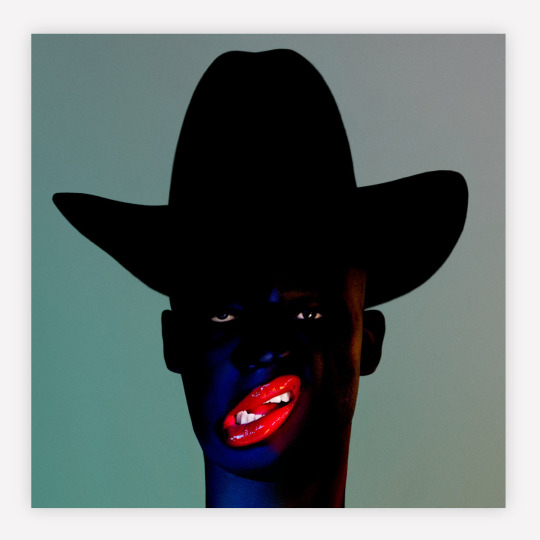
Young Fathers - Cocoa Sugar Ninja Tune, 9 March Artwork: Tom Hingston
Selected by Katie Chandler // IT003
This cover was immediately striking and memorable to me. Upon listening to the album, I found that the artwork resonated with this feeling of odd, unrestricted expression. It's a little unsettling, ultimately bold and intriguing. Much like the music, it feels hot and cool all at once, like a burst of energy that leaves you in a sweat. It's the exhilarating soundtrack to your runner's high, and you're not really sure why you're running or what you're running from.
➔ Listen to Illustrated Tapes 003: Porch Light by Katie Chandler
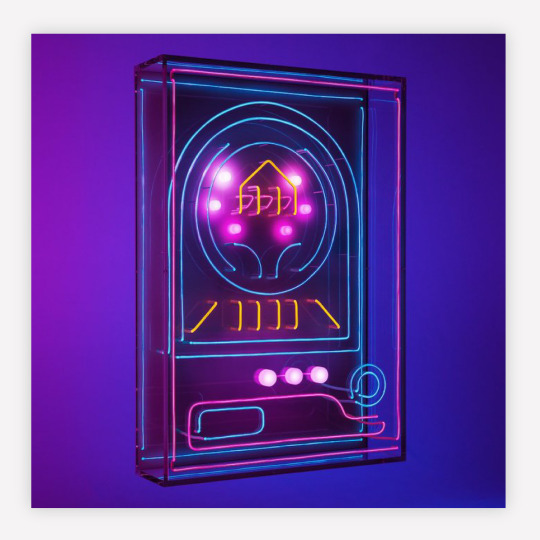
Gesu no Kiwami Otome (ゲスの極み乙女。) - Suki Nara Towanai (好きなら問わない) Taco Records, 29 August Selected by Greg Stasiw // IT009
Although it’s not the ambient and electronic fare I usually enjoy, Suki Nara Towanai (好きなら問わない) by Gesu no Kiwami Otome. (ゲスの極み乙女。) is a hoot. The artwork features a stylized neon pachinko machine. Or maybe it’s a console in a rad indie pop spaceship, which would also make sense for this funky fresh group! It feels somehow familiar, somehow alien, and altogether really, really cool.
The neon suggests something retro, and there are some retro leanings in their funkier tracks, but it's definitely neon as seen in 2018. Modern pop (and J-Pop) tropes emerge, but infectious basslines, tight drumming, and smart keys make this album something special. Some math rock even surfaces at times, and the remix included proves that this group goes for whatever feels fresh. One look at the artwork reminds me that this is one of the funnest albums I've listened to in a while. “Funnest” is definitely a word when you’re talking about this band!
➔ Listen to Illustrated Tapes 009: Atmospheres by Greg Stasiw

Aphex Twin - Collapse EP Warp, 14 September Artwork: Weirdcore
Selected by Alex Vissaridis // IT002
2018 was a great year if you grew up listening to the music I was into. Some of my all-time favourite artists released new stuff this year, and they didn’t disappoint. The artwork was pretty excellent too, but nothing grabbed my attention like the world created around Aphex Twin’s Collapse EP. Album art doesn’t seem to mean as much as it once did, so it’s always exciting when it appears outside of the little square on your screen in unexpected ways.
This year, Aphex Twin logos appeared all over the world, from Elephant & Castle tube station to the side of a record store in Tokyo, designed in a way that made it look like the logo was collapsing into the environment around it. I’m a sucker for stuff like this; random cryptic messages that send internet detectives into a frenzy. It was eventually announced as marketing for the Collapse EP, but they kept the ‘collapsing logo’ visual going on the EP artwork, in the music video for the track ‘T69 collapse’, and even through to projection-mapped videos around London (again announced in typical smoke-and-mirrors fashion) and a collaboration with Crack magazine. Way more than just a collection of pixels.
➔ Listen to Illustrated Tapes 002: Tape Fuzz by Alex Vissaridis

Flohio - Wild Yout EP Alpha, 2 November Selected by Rachel Maughan // IT012
I got into Flohio after I saw her on COLORS in January with 'Band'. She's fucking explosive on that track, you can feel her spitting straight into your chest. She's been savvy with her producers and killed her work with God Colony - 'SE16' was my most played track of the year. Her 2018 EP, Wild Yout is a cocktail of perfection.
Mashing up genres it's a high energy listen with punchy, grimey hip-hop that is uniquely South London. The artwork is beautiful simplicity - her achingly slick androgynous aesthetic, the clean photographic composition, with a flowing chain to bring it tightly back to SE. Gorgeous.
➔ Listen to Illustrated Tapes 012: High Rise by Rachel Maughan
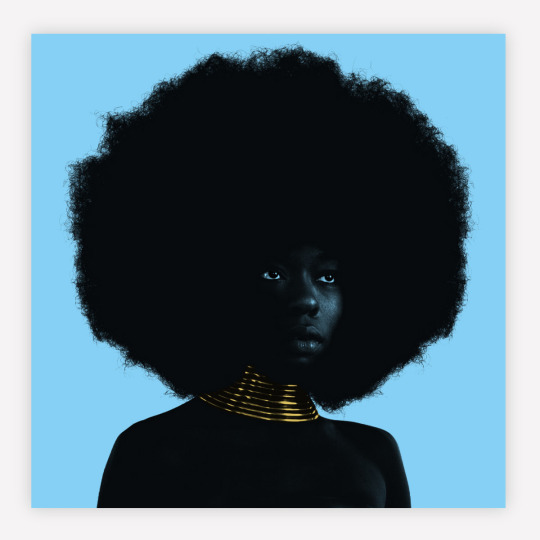
Sudan Archives - Sink EP Stones Throw, 25 May Photography: Jack McKain Design: Jeff Jank
Selected By Tom J Newell // IT004
Sink submerges the listener in flowing loops and beats, with splashes of violin and vocals floating above the sunken monolith, which stands tall on the deep blue cover art. The composition is reminiscent of two of Jank’s other iconic Stones Throw sleeves, Donuts and Madvillainy and continues his striking yet varied art direction for the label.
Check out the ‘Nont For Sale’ video from the EP too, which adds powerful choreography and styling to create another successful visual accompaniment to the music. Much love to Sudan Archives and hats off to Jeff Jank. I painted a tribute to the cover art on a 12x12” piece of wood.
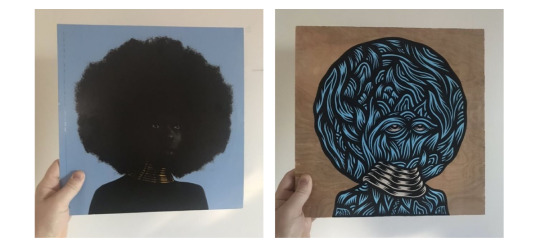
➔ Listen to Illustrated Tapes 004: FEAR. by Tom J Newell
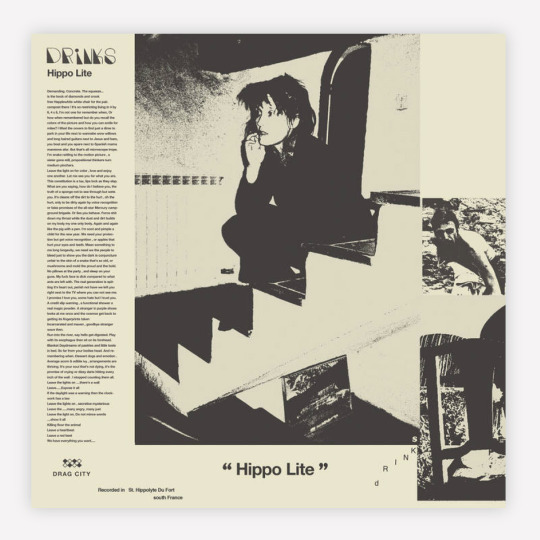
Drinks - Hippo Lite Drag City, 20 April Selected by Molly Fairhurst // IT015
Hazy, dazed, an album I hold dearly to 2018 (and many strangely lit walks in a then new, unknown city).
A collaboration between Cate Le Bon and White Fence’s Tim Presley, the pair took an (isolated) retreat to St Hippolyte-Du-Fort in the south of France to record, frankly, crudely, seemingly, whatever the fuck they wanted to. Hippo Lite is born, a joyful, playful, sometimes quiet, sometimes screaming object.
What senses like an eavesdrop through closed doors rightly has a cover that can’t be quite understood- a narrow column of, at the glance of the reader, ‘nonsense’ notes, which flank photos of Le Bon and Presley. Both are snapshots of an absurd holiday we have been invited along to, so long as we sit across the table. A tender and private piece.
➔ Listen to Illustrated Tapes 015: The Wilder Woman by Molly Fairhurst
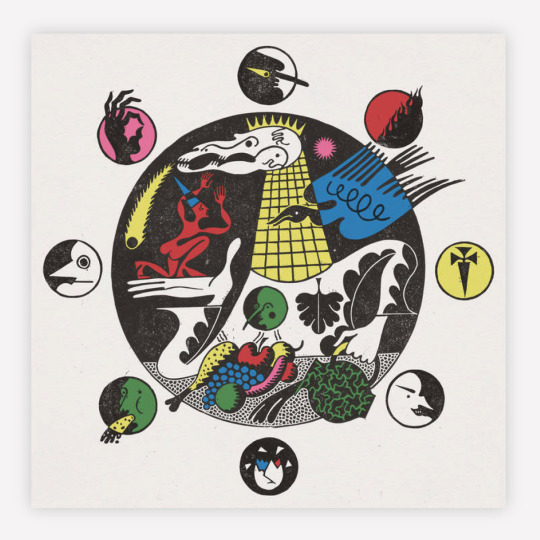
Pigs Pigs Pigs Pigs Pigs Pigs Pigs - King of Cowards Rocket, 28 September Artwork: Sophy Hollington
Selected by Drew Milward // IT010
First off, this album is wall to wall, solid gold bangers. Kind of like the lovechild of The Fall and Black Sabbath, who has been cautioned by the police for possession of a massive bag of skunk, a bong in the shape of a skull and a copy of ‘The Holy Mountain’ on DVD.
Aside from the fact it’s a full on riff-o-rama, the artwork by Sophy Hollington is absolutely incredible. It summons up the sound of the band, via folk horror infused wildness. It really captures the sonic landscape of the album, yet completely avoids any of the cliched imagery that could so easily have taken its place. It really is the whole package.
➔ Listen to Illustrated Tapes 010: BE GONE, YOU CREATIVE GREMLINS! by Drew Milward

Djrum - Portrait With Firewood R&S, 17 August Artwork: Michael Mitsas
Selected by Sam Ailey // IT001
Portrait With Firewood is one of those rare gems within the electronic genre - a true ‘album’. With holistic production, emotional range, and a captivating narrative, this really is a stunning listening experience from start to finish. Felix Manuel combines electronic and acoustic sounds seamlessly on this intimate record, with exceptional attention to detail in his sampling and tender piano sections played by Felix himself.
Michael Mistas’s cover art is a real departure from the typical design aesthetic of electronic albums and caught my attention straight away. I love its composition and rough, imperfect execution. To me these feels reflective of the range and depth of emotional states explored across the album, and the feeling that some things are easier to express through your craft than with words. Plus I’m a sucker for pink things.
➔ Listen to Illustrated Tapes 001: Quiet by Sam Ailey
4 notes
·
View notes
Text
Review: Suzzy Roche and Lucy Wainwright Roche Combat Isolation With Harmony on 'I Can Still Hear You'
Thanks to Julie Andrews, the world knows that “a spoon full of sugar helps the medicine go down” and lord knows 2020 has been one large choker of a spoonful of medicine. But mother and daughter duo Suzzy Roche (of Irish/American folk group The Roches) and Lucy Wainwright Roche (also the daughter of folk rocker Loudon Wainwright) are doing their best to provide the sugar, bringing their sweet, almost fragile, harmonies to songs about the isolation of the pandemic, personal loss (Suzzy lost her sister and bandmate Maggie and her mother in 2017), and a world increasingly marked by divisiveness, misogyny, and hate. Their album, I Can Still Hear You, is out now.
An interesting thread running throughout I Can Still Hear You is the use of animals to deliver its messages. This is nothing new, of course. Anthropomorphic animals have often been used to illustrate lessons about the human condition, from Aesop to Grimm, Roger Waters to E.B. White. The latter's boy/mouse Stuart Little gets a nod on this album, in the song “Little.” Instead of the fun adventure of the book, “Little” explores the terrifying prospect of being different (in this case, small) in a world. But ultimately, “Little” is a tale of perseverance and taking advantage of those limits. “I slipped through the cracks in your wall.”
Another take on the fairy tale is “SwanDuck Song.” A reverse take on “The Ugly Duckling” finds a swan who literally transforms into a duck without warning, and spends the song trying to fit into her new reality, lamenting the loss of her “long smooth neck, elegance, and grace. Got a bad case of duck face.” The song's SwanDuck is told that “from now on no swan will be your friend, but there'll be more ducks around the bend.” But is also warned it requires work on her own part “but only when you swim the muddy water with your two duck feet.” Roche then hits you with the album's best single line, and one that hammers home just how much the SwanDuck resembles many humans who find themselves navigating life without a rudder due to loss. “Your strange new heart doesn't even recognize its beat.”
The album's title track was written by Wainwright Roche after the duo had to flee Nashville in the middle of recording the album to get back home to New York before COVID-19 locked down travel. Entering a city normally teeming with humanity that was suddenly transformed to a ghost town, “I Can Still Hear You” is a reminder that, just because the people aren't visible, they're still present and connections are critical, even if those connections have to temporarily be auditory rather than visual.
Of course, no song featuring talking animals could be complete without a nod to arguably the most famous anthropomorphic animal in the world, Kermit the Frog. Fortunately, “Bein' Green”, with its message both of the worth of people (or frogs) of all colors and being comfortable in your own skin slots in well with the overall theme of I Can Still Hear You.
“Joseph D” is another standout. A violent misogynist, Joseph also sleeps with a teddy bear to protect from his own “lifelong nightmare.” Throughout, the violent man exhibits fragile childlike tendencies to correspond with his toddler-like tantrums. It's enough to give the impression that, while Joseph could very easily be a “Proud Boy” (something that is my interpretation, not theirs, in fairness. Please don't go yell at the Roches...), he isn't really all that proud in private.
Helping the duo out on the album are a pair of well-known artists, The Indigo Girls. Emily Saliers and Amy Ray make separate appearances on guitar and vocals. The album also features production by Jordan Brooke Hamlin and instrumentals from some of Nashville's best sessions players.
Overall, the whimsy works. There are plenty of down tempo dirges about the present state of affairs. By packaging these songs in sweet harmonies and lush instrumentals, they're somewhat easier to swallow. Like Andrews' spoonful of sugar, the medicine goes down, if not easily, at least slightly less bitterly than it has all year long. And for that, I'm thankful that I Can Still Hear You exists. We can always use a little sweetness right now.
#americana#album review#nashville#folk#suzzy roche#lucy wainwright roche#2020#concerthopper#new music#music
0 notes
Photo

First 100 down. 96. “Rockin’ the Suburbs,” 97. “Ben Folds Live,” 98. “Songs for Silverman,” 99. “Way to Normal,” 100. “Stems and Seeds,” 101. “Lonely Avenue,” 102. “So There” by Ben Folds
I owe Nick Hornby for the introduction.
The High Fidelity author’s collection of essays on pop music, Songbook, made the case for Ben Folds’ contributions to the canon in a chapter on “Smoke.” Hornby writes so persuasively, in a deceptively casual style that I’m perhaps a bit too pretentious to ever approach with my own pop culture writing. There’s a lot of music covered in his book that I failed to investigate on my own. But that particular passage must have triggered something in the back of my mind, some residual impression of “Brick,” perhaps, which sent me to the Web for those first BFF tracks (none of which were “Smoke,” by the way, though I agree with Hornby’s appraisal of its lyrical strength).
It quickly became a total fandom— I now have all the official LP’s, band and solo, and the EP’s are floating in the digital ether of hard drives and burned discs. I even bought the soundtrack to the little-remembered Dreamworks quirky CG animal picture Over The Hedge, to which Folds contributed several original tracks (a soundtrack that marked his most recent collaboration with William Shatner, a pairing that also yielded a full-length, Has Been, which is a simultaneously ironic AND unironic great listen.) No one is going to bestow the crown of ultimate Ben Folds fanboy on my head— I’ve ONLY seen him live twice, and neither time was even with a symphony orchestra! Nevertheless, I’ve been following his output for a good decade, and my record is solid.
His records are also solid (as is this excellent segue), exploring the outer limits of musical flavors available to a largely pop-oriented guy with a piano and an ear for harmony. Rockin’ the Suburbs (#96), his first post-Five record (exempting Fear of Pop: Volume 1, an experimental doodle from the era of the Messner recordings, which I only mention to smugly show off my bonafides yet again), incorporates synthesizer squeals, a Korn-parody guitar breakdown, treated keyboards, and strings, but his ivories are still at the forefront. His lyrics here are the ultimate template for the rest of his career, featuring: the irreverent humor of a class cut-up (like “Rockin’ The Suburbs’” self-aware chorus or the climactic, harmonized shout of “Motherfucker!” that ends “Fired”), the incisive character sketches of a short story author (“Fred Jones, Pt. 2” is a mini-masterpiece of well-observed details, but I think “Carrying Cathy” is downright shattering), and the delicate balance of sentiment any memoirist must strike (“Still Fighting It” hits the bullseye, but “The Luckiest” is a bit too goopy for me).
I have always had a big soft spot for Songs for Silverman (#98), which has been painted by some critics and BFF fans as a turn into mopey adult contemporary. There are a couple of skippable tracks, for sure, but it doesn’t sound as far from the old days as the doubters believe. After handling most of the instruments on Suburbs by himself, and doing a quite literal solo tour- just the man and his Baby Grand- as documented on the superb Ben Folds Live (#97), Folds missed the sonic chemistry that came from having a band in the studio. Though Jessee and Sledge had followed their own paths (the former touring with Sharon Van Etten, the latter adopting an existence of a lower key than the music business), Folds assembled a more than capable bass/drums duo to pump up the jazzy breakdown in “Bastard” and the chorus of “You to Thank.”
“Landed,” even without the orchestral strings that he later decided overwhelmed the melody, has rightfully earned its place in the classic Folds firmament. Hearing the introductory notes at my first Ben Folds show was enough to conjure a lump in my throat. Seemed weird for me to get unduly emotional about it: the chorus is upbeat (complete with signature “Ba-ba-ba-ba”s) and the story of a man emerging from a controlling relationship is not something I’ve experienced or even witnessed, so I can only interpret this as a reaction to the beauty of hearing a masterful pop song.
As the Web became more of a presence in daily life, and piracy was taking huge bites out of the music industry, Folds ably kept pace with the evolving relationship between an artist and his fans. That included embracing the nascent social media networks- which by the mid-2000s meant MySpace- and posting new music before it hit the streets. During my first couple years of college, I had one of these tricked-out profiles myself. This may have been the way I first heard, in 2008, the “fake” tracks.
Alternately crude and tremblingly earnest, they were a collection of “leaked” songs ostensibly from Folds’ forthcoming album, Way To Normal (#99). There was “Bitch Went Nutz,” a 1st person narrative about a Republi-bro scandalized in front of his peers by his Anarcho-Socialist fuck buddy that plays like the most profane “Weird Al” Yankovic pastiche ever. And “Cologne (Piano Orchestra Version),” a stunningly pretty concerto-ballad that gets absurdly overblown with a chanting male chorus and a dozen keyboards playing at once. And a handful of winkingly self-serious social justice ballads. All written and recorded, it was later revealed, in about a day, and launched into the bootleg blogosphere as a prank.
These were eventually officially released on Stems and Seeds (#100), alongside alternately-mastered versions of the “real” songs. The legitimate tracks found on the official LP are only slightly more tasteful, with a somewhat explicit Divorce Record vibe on kiss-offs like “You Don’t Know Me” (with Regina Spektor lending her magic) and “Brainwascht” (about the battle lines that can be drawn between mutual friends of split couples). When the lyrics are slightly regrettable (like the stereotype-mining “Bitch Went Nuts”), the melodies usually carry it. Exceptions would be the intentionally-grating “Errant Dog,” and the limp celebrity satire “Free Coffee” (skippable on record, but in live shows, Folds illustrates how he gets the treated piano sound by placing Altoids tins on his strings, which is a bit of nerdy fun).
Things came pleasingly full circle when it was announced that Folds was co-writing an entire album with Nick Hornby. The mutual appreciation society of these two artists had become a collaboration outlined right on Lonely Avenue's (#101) cover art: “Ben Folds Adds Music and Melody to Nick Hornby’s Words.” It’s a magical working relationship mirrored in their biographical tribute “Doc Pomus,” about the irascible musician who penned classic rock standards like “This Magic Moment” and “Save The Last Dance For Me” alongside Mort Shuman. This sense of pop history permeates 70’s-influenced arrangements like “Password” and “Belinda,” the latter about a Manilow-esque crooner reflecting on the love that inspired his greatest hit, who he callously abandoned for a fling with a flight attendant sporting “big breasts, a nice smile, [and] no kids, either.”
My 2 favorite tracks are a study in tonal opposites: “Claire’s Ninth,” a delicately affecting portrait of a young girl in the middle of a chilly but courteous divorce, and “Saskia Hamilton,” a gleefully nerdy ode to the most phonetically pleasing poet’s name ever. Their musical commonality is that neither one is a slow-tempo plaintive ballad, which have their place, but are the Folds tunes that I tend to skip in his later releases. “Claire’s” chords are jazzy and gently driving, with gorgeous vocal harmonies in the chorus; “Saskia” is frantic, driven by old school Moog synthesizer, with quirky flourishes like the female opera singer making a vocal cameo in the breakdown— it feels like a mutual homage between the song’s authors to “Weird Al”’s more esoteric original compositions.
So There (#102), while technically reaching full-length status with the inclusion of a real-deal “Concerto For Piano and Orchestra,” feels oddly slight. It was hyped by the artist himself as a unique new collaboration: pianist and new classical ensemble making pop songs together. He had experience with performing full-orchestra arrangements of his older songs (as on the excellent DVD “Ben Folds and WASO Live in Perth”) and overdubbing strings on new recordings, but this he advertised as a from-the-jump co-written project with yMusic, a sextet of players bringing strings, woodwinds, and brass. The Chamber Pop tracks that result have their delicate beauty, but the album resists falling into a snoozy easy-listening trap by alternating the ballads with the kind of sprightly, pazz and jop numbers that similarly kept Silverman moving.
It’s all just so… pleasant, and it seems to slip out of my mind and soon as I’ve heard it. If you were to strip-mine it for a Ben Folds playlist, I would pick out the title track for one, with its trilling strings, burbling brass, and father/daughter harmonizing. The instrumental section after the first chorus- what it might be appropriate to call the 2nd Movement- gets closest to fulfilling the promise inherent in the album’s Chamber Pop experiment. I might sound overly harsh on this release— re-listening to it while writing this post, there’s nothing that’s a huge turnoff, or a waste of time (except maybe the metaphorically one-note novelty track “F10-D-A,” which, granted, doesn’t outstay its welcome, running a second under 2 minutes). However, nothing there really sets my heart on fire like the first time I heard the swirling arpeggio of “Zak and Sara” (first through the raucous solo piano version on Live, then the filled-out studio recording on Suburbs), or the chorus of “Landed,” or first “ba ba BA ba ba ba!”ed my heart out as a human “Army" trumpet in the crowd of my first Ben Folds show.
#Ben Folds#benfolds#cdcollection#cdcover#pop music#piano pop#Nick Hornby#Zak and Sara#Landed#Annie Waits#Rockin' The Suburbs#Songs for Silverman#yMusic#classical#chamber pop
2 notes
·
View notes
Text
“From The Bottom Of My Broken Heart”
The Taboo Fantasy of a Pop Star Turned Porn Star, or: Britney Spears Is The Devil
Released: 12/15/1999 Directed by Gregory Dark Rating: 3.5/5

This week I’m watching “From The Bottom Of My Broken Heart,” the fifth single off Britney’s debut album ... Baby One More Time. I thought I’d review a ballad this time for a change of pace. I was surprised again at yet another narrative-driven video, although it makes sense that there’s not a whole lot of dancing going on given the tempo. Still, I keep anticipating one that’s like basically one big choreographed routine shot from different angles. Maybe next week.
One big difference that sets “From The Bottom” apart from “Womanizer” and “Toxic” is how on the nose it is. “Womanizer” is about a womanizer, but the plot diverges from what is happening in the lyrics. “Toxic” is even more abstract, using the literal interpretation of the title while telling the story of a stewardess/super villain bent on poisoning her unfaithful lover. “From The Bottom” is a song about losing your first true love, and that is exactly what the music video is about too.
The story behind the video is a bit of a tragicomedy, according to Wikipedia. Director Gregory Dark was instructed to do damage control after the sexy schoolgirl stuff of “... Baby One More Time” had “tainted” Britney’s image by making something more innocent and serious. Unfortunately, after this video was released, it came out that Gregory Dark had previously had a prolific career directing porn!! Seriously. Britney’s spokesperson claimed they had no knowledge of his pre-music video directing days, but the damage was done. Everyone proceeded to FREAK the FUCK out, no one more than Alec Hanley Bemis writing for LA Weekly.
Before I dive in to his dumbass article called “The Devil in Miss Spears,” I just want to point out that at the time it was published, Britney had just turned eighteen exactly two months before. I wanted to just pull out a few quotes, but it’s so fucking asinine that I ended up with this annotated abridged version.
Is it her lack of musical talent that people find distressing? Well, sure, that’s part of it. At the moment, competition in the diva-lite field is particularly intense, with Christina Aguilera, Mandy Moore and Jessica Simpson among the bodacious blond teens competing for Billboard dominance.
I keep running across people that say Britney is a bad singer, and I whole-heartedly disagree. I think she lacks conventional, clean vocals, but that’s what gives her an edge over I guess fucking MANDY MOORE. Not to hate on Mandy but like get real Alec you were so wrong about this????
Spears’ new video, “From the Bottom of My Broken Heart,” puts her on the fast track to adulthood. The clip finds her leaving her old boyfriend behind and taking a bus to somewhere . . . But where? Who‘s in bed with Britney now? ... [T]he only verifiable fact we have to work with is that Spears has started running with a darker L.A. crowd.
“Who’s in bed with Britney now?” Sounds like a really awkward way to segue from talking about a wholesome, boring as shit music video to talking about porn but OK. Those first two sentences are the only two sentences Alec writes about the video in this article that is supposedly about the video.
One piece of evidence is that her new video is directed by Gregory Dark, a triple-threat writer, director and producer known not only for his work on videos by bands like Orgy and the Melvins, but for a 15-year-plus career as a groundbreaking pornographer. A former film-school student at both Stanford and NYU, Dark is renowned for crafting the most decadent XXX on the market. As Hustler writes, “Dark‘s movies are more like nightmares. Twisted and fevered . . . Every treat has a gooey center, but beware the few that slip past containing the occasional jagged piece of glass.” The titles of his movies alone -- White Bunbusters, Fallen Angels, The Devil in Miss Jones 3: A New Beginning -- hint at a possible chronology for Spears’ career in days to come. Will this Cinderella sully the slipper? Will we all eat glass?
My favorite part is how he acknowledges that he is projecting puritanical Disney princess level expectations on to this grown woman and somehow feels justified in punishing her when she doesn’t live up to them. Also, because one of her music videos was directed by a guy who used to direct porn, she is now going to become a porn star and not only that, but her becoming a porn star will result in the equivalent of forcing a bunch of people to eat glass. Sure, Alec.
Spears already has a history of questionable decisions. ... At Dodger Stadium‘s Wango Tango event this past summer, Britney spiced up her 20-minute set by wearing shiny black leather pants and what can only be described as an elastic breast hammock. This brought to mind the questions surrounding her contemporaneous “knee” surgery and the unusual swelling that accompanied it. Say, around chest level.
I have nothing to say about this, just wanted to show y’all the scandalous “breast hammock”:

He says some other fucked up shit but let’s just skip to the end.
Now that Spears’ album has Soundscanned a startling 11 million copies, it‘s time to admit that the new teen pop isn’t heavily coded XXX made for and marketed to teenagers. In fact, it‘s explicitly made and marketed as such. “From the Bottom of My Broken Heart” contains no avant-garde film techniques, but Britney’s lips glisten so . . . Speaking frankly, this light in our lives hurts us, from the fire in our loins to the bottom of our broken hearts.
First of all, I wanted to tear my eyeballs out after reading that last sentence, so I’m sorry for subjecting all of you to that. But what the fuck? Basically he is saying that his sexual attraction to her is her fault and HURTING HIM and everyone else who is attracted to her and just what in the fuck are you DOING. Second of all, I don’t even know how to explain how fucking ridiculous it is to act like “From The Bottom” is even remotely pornographic (and honestly Alec can’t either, other than point out that she’s wearing lip gloss which somehow makes this some X rated shit) other than write a long ass blog post about it, which is exactly what I planned to do anyway, so buckle up.

The video opens with a quick shot of her on this swing and then we jump right into the story. Britney hauls out a giant blue suitcase and hugs her mom and sister goodbye.


We then get a quick shot of Britney lying in this field of sunflowers, which is basically the Diamond Britney of the video—the nondiegetic shot where she rolls around singing with the sole purpose of looking good.

We rewind a little bit to see Britney packing her bags. I have to say that while the story is boring as shit, the way of telling it is at least livened up a little by the nonlinear timeline.

Oh, we also get a quick cut to Britney on the swing again, which serves as the second Diamond Britney of the video.

OK, back to her packing. In terms of rebuilding her “good girl” image, they’re definitely trying, with the cutsey room and the doll and everything.




Two things really bother me about that last shot: one, what the heck is her doll doing out of her suitcase! We JUST saw her pack it. Two, what the heck is this yellow sphere that she lovingly looks at? I guess only true 90s kids will remember.


We get a few shots of her sitting on the porch, first alone with her suitcase and her cute ass hat, and then with her First True Love. Then, just before the chorus kicks in, there’s this series of weird ultra fast cuts where you can’t actually register what’s in the frames. I tried to capture them using the super advanced technology of hitting the screen capture command as quickly as I could. I managed to catch two of the frames: One of her bedroom wall, and one of this butterfly.


Then flashbacks of her relationship with her First True Love begin, interspersed with Porch Britney and Swing Britney and Sunflower Britney singing. Woo!



First, they run like dinguses and then they climb up this wooden water tower (?) in the middle of the night. Romantic!
The chorus kicks in, “You were my first love, you were my true love / From the first kisses to the very last rose,” and right when she sings “rose” there’s a shot of her in a garden of roses. Wowee zowee!

Then the next flashback segment starts, this time with them goofing off on a football field at night. Also, a quick shot of Britney back on the water tower but this time by herself. Sad.



The whole video is worth it just for this shot of Britney making this face.

Seriously though, if I’ve learned anything from doing this blog so far, it’s that Britney is goofy as hell, and it seems like she can’t resist hamming it up at least a little bit in every video, even in this ultra melodramatic serious one.


A couple shots of them cuddling then brings us to present day Britney waiting at a bus stop.



For the next minute or so, the video definitely drags. Nothing new happens, besides Britney singing in front of the big Cedar Springs billboard (without the hat on for some reason). There’s more of her canoodling with her First True Love on the porch and on top of the water tower.




The more I look at these stills, the more I realize there was an effort to tie together some of the visuals—the sunflowers from the field also appear on the billboard and by the bus stop, and the billboard has an illustration of that wooden water tower.
Sunflower Britney makes a couple more goofy faces with a flower on her head.


Back to the water tower AGAIN, switching back and forth between Britney alone and with her First True Love.




Uh oh, looks like he’s got something mischievous planned by the look on his face...

HAHA! He pranks the shit out of her by shining a flashlight on his face. It totally charms her and then they kiss.


Also she’s got this sick purple eye shadow on.

Finally we get things moving with a little drama. Britney and her First True Love break up on the porch, and FTL does some horrible pantomiming of grief. Then he gets up and leaves and Britney can barely even muster sadness, she just looks exhausted and honestly after that display I don’t blame her.




Back in the present day, the bus arrives. For some reason it’s nighttime in the first shot but then returns to daylight when Britney boards.



She looks back one last time before she gets on and the bus pulls away. But wait!

Her First True Love pulls up in his red Jeep, but he’s too late. Blast! He kicks the dirt (unfortunately couldn’t get any good stills of that) and then he makes these faces, which I guess express how much despair he feels.



There’s this extra weird shot with racking focus that shows the billboard behind him and I’m not sure why it’s in there but it’s hilarious.

Britney, who is definitely superior at facial acting, pouts on the bus.

Finally, the video comes to an end with two shots of Britney walking away from the swing, bringing us full circle.


I actually did enjoy this video more after watching it more than once, but I still think it’s pretty boring. The best parts are when Britney is being goofy, but it also goes against the tone the video seems to want to establish. Ultimately, it’s a lot less self-aware than “Toxic” and “Womanizer” and I think that’s what holds it back. I appreciate even more all the creative liberties and risks that “Toxic” took after a video like this which takes no risks and lacks creativity. The layered flashbacks kept it from being a total snoozefest, but they also were repeated too many times and they definitely reused footage at least once. So, with my totally made up rating system, I give it a 3.5 out of 5.
After watching that, can you believe the nerve of Alec Hanley Bemis? I guess I already devoted enough time to talking about what a fool he is, but going over this video in depth just really drive home the point that Britney, even at this super early point in her career, was totally doomed when it came to the media’s expectations of her. She was at once a totally manufactured fake puppet being controlled by the music industry, and also fully autonomous and responsible for being a big ol’ nasty breast hammock wearing slut.
Thanks for reading, and check back next Thursday, when I review Gimme More.
Resources “From The Bottom Of My Broken Heart” official music video: https://www.youtube.com/watch?v=fHPnGqXXUmI “From The Bottom Of My Broken Heart” Wikipedia: https://en.wikipedia.org/wiki/From_the_Bottom_of_My_Broken_Heart Alec Hanley Bemis’ LA Weekly article from 2000: http://www.laweekly.com/music/the-devil-in-miss-spears-2131598
1 note
·
View note
Text
A Rush of Blood to the Head: Sensuality and Substance in LIGHTS’ ‘Skin & Earth’ Era
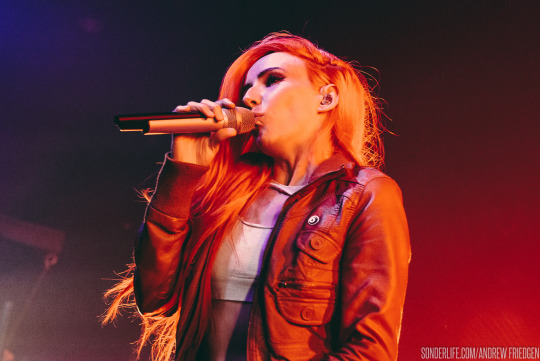
Ruts and stagnation can be difficult to avoid for musicians as their careers progress if interest dwindles, labels lockdown, or plain old boredom enters the process, and you’ll hear it.
You can flop, or you can go all out. For Canadian synth-pop trailblazer Lights Bokan (often stylized LIGHTS), she went all out.
Skin & Earth, the latest by the Timmins, Ontario native, doesn’t exist just as a music album. It’s also been given another life: Lights not only recorded the music but wrote and illustrated an entire comic series to go with it. She’s dabbled in the comic (and animation) world back in her early days with Audio Quest: A Captain Lights Adventure, but this is an all-in sort of endeavor.

It’s familiar territory for her long-time fans, though. Those who have stuck with her over the years have come to expect her to push creative boundaries, or at least keep things interesting. Some of those ventures include stripping away her electronics to make gentle acoustic versions of her albums, selling original paintings, or religiously making vlogs and doing livestreams. But even as far her records go, you won’t get bored transitioning from one to the other. Each has its own character, from the dreamy soundscapes of The Listening to the cold adventuring spirit of Siberia to the pep of Little Machines. Even her acoustic albums have different structure and depth from one another. If there was ever a musician that you wouldn’t expect to get stale, it’s Lights. When you hear her voice, there’s no mistaking her for anyone else out there.
This is the case for Skin & Earth as well. Even disregarding the whole other world that the comic series brings in, Skin & Earth is another distinct chapter in her discography. Skin & Earth is a totally different Lights – sexy and groovy and unapologetic. Literally, too, as she emulates the aesthetic of her comic’s main character En, most notably with scorching, fire-red hair. But it’s also just enough like previous albums that you’re not going to be totally alienated. This is a line she has always toed well.
The album eschews the baked-in dance and synth elements of Little Machines for drum-and-bass pop, songs with r’n’b rhythm and trap beats and vocal flow we haven’t really heard from Lights before. This isn’t to say that classic Lights elements aren’t there (“Giants”), but there’s a definite theme to Skin & Earth. In fact, some of the songs that embrace this new direction the most are the best on the album. “Kicks” is the catchiest, “Skydiving” is titillating and adventurous, and “We Were Here” is wispy and mysterious, a song for late-night drives. But Lights is no one-trick-pony. Skin & Earth features some innovative meanderings, notably the emotional and gentle “Morphine,” the sludgy “Savage” (featuring drumming from Twenty One Pilots’ Joshua Dun), and the big closing anthem in “Almost Had Me,” perhaps her strongest album ender yet. Skin & Earth wears its best qualities on its sleeve. “Morphine” and “Moonshine” are clearly not songs about substance use, but rather, intoxication is the messages’ medium. “Skydiving” may or may not be about sex, but it easily could be. The primal, tactile nature of the album’s title feeds directly into both its musical composition and lyrical content.

Lights’ personal re-invention, from the scorching red hair to her new musical direction, commands the mythology of this album. Many artists conveniently stumble into re-defining themselves for new record cycles; Lights has done so genuinely and with more authority than others by bringing her fictional avatar to life. Again, it’s an all-in approach. In fact, so much about Lights’ aura on and off stage defines and tints her career. Her motherhood (she has one child, Rocket), her feminism, and her creative independence may not always have a direct, one-to-one translation to her music, but it impacts how you view and understand her music.
This is why her live sets are so attention-grabbing. There are few musicians who catch your eyes and ears like she does – perhaps Tycho, with their immersive analog synths and invigorating visuals, or Twenty One Pilots with their frantic passion, but it’s a short list. Somewhere between campy over-indulgence and apathetic boredom sits a sweet spot for live performances, and Lights is part of the 10 percent or so in that sweet spot. Awash in vivid red, purple, and blue lighting, she played a range of songs from Skin & Earth and Little Machines, while alternating Siberia’s “Flux and Flow” every other night. On this tour opening for PVRIS, you won’t find many deep cuts or acoustic sessions or anything from The Listening era, which is unfortunate because those deeper paths through her catalog are the true Lights experience, usually relegated to headlining slots. In fact, the idea of her opening for PVRIS really shows the craze that band has cultivated and tapped into, even when Lights was halfway through her career when PVRIS started playing shows.
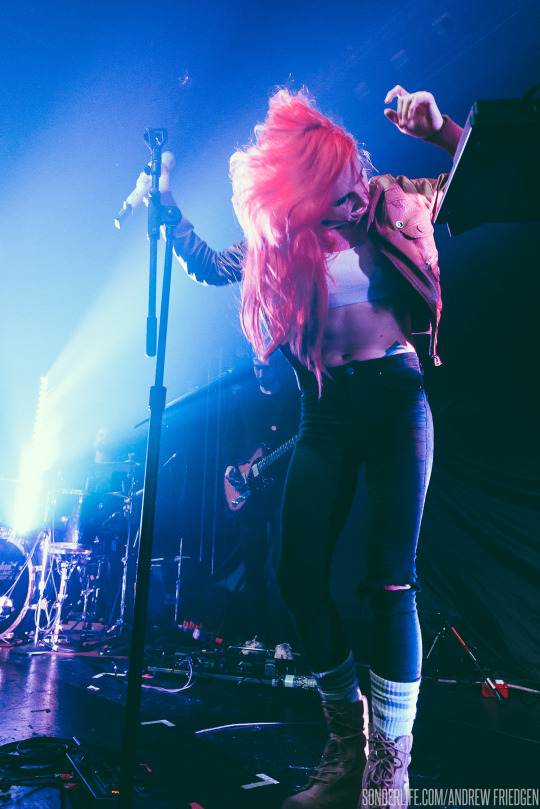
Her contrast with the moody and dark electro-rock band might seem counter-intuitive, but the juxtaposition is actually what separated her and made her distinct, especially with the aforementioned brawn of the new songs. Many of her songs are meant to groove to, and groove to them she does. She actually gets away from her keyboard and roams the stage more frequently than she has in the past – a good step for a show that is primarily carried by the strength of her unmistakable singing voice.
It did feel strange only getting a relatively small section of her discography after having experienced years of buildup from early tours packed with songs such as “River” or “My Boots,” but that’s the way these things go. Skin & Earth deserved the majority of her set list anyway, not just because it’s her brand-new record, but because it lives on such a larger scale through the comics.

The staggered release of the comic book issues (a few came out before the album, and a few are still due to be released) helps keep attention and interest alive in a way that’s useful and entertaining for the instant-stream, now-now-now music world. New issues give people a reason to go back to the album even after digesting it. But it will be interesting to see where the whole Skin & Earth package, from all comic issues to the album to the effervescent artist herself, is in another six months or so. In the meantime, there are still a few dates left to her tour with PVRIS where you can experience that whole package.
---
Article and photos by sonder editor Andrew Friedgen. Like this? Sonder is an independent music, travel and photography publication at sonderlife.com. Give us a follow here or at our Twitter, Instagram or Facebook if you like this!
SEE ALSO:
All of our photos and features from PVRIS’ 2017 North American tour
Retro vibes and neon drizzles from Los Angeles-based Party Nails
Our complete list of bands we’ve photographed
4 notes
·
View notes
Text
THE PERMANENT RAIN PRESS INTERVIEW WITH CONNOR FRANTA

“I think people in this generation are the most aware of the uniqueness of humanity than they have ever been before. It’s very important that we continue to preach equality amongst everything besides just sexual orientation, religion, race, gender equality... and I thoroughly believe that this generation is and will change that into a very equal future for everybody.”
A strong statement from a passionate young artist—one who himself, inspires a flourishing generation of creators, dreamers and advocates. Connor Franta is no stranger to the Internet and its powers. Following his first YouTube video upload in 2010, his channel has amassed over 5.5 million subscribers. Labelled the “Next Millennial Mogul” by People Magazine in 2015, Franta’s debut novel, A Work in Progress, was a New York Times bestseller. Late April marked the release of his sophomore book, Note to Self. A more vulnerable, inner piece of dialogue in comparison to its predecessor, Franta writes about his experiences with clinical depression, anxiety, and acceptance.
“I find myself over an interesting point in my life writing down my thoughts, experiences, and my quite literal, words of wisdom to myself for cathartic purposes. 6 months after I began, I realized I had such a large collection of these different things. I felt like I could put it into a book, and hopefully it would relate to other people in some sort of small way,” he says of its contents. Writing from the heart, Franta is candid in each little “note to [himself]” and involved in all aspects of Note to Self’s composition–including its stunning visuals.
A newer aspect to his writing, and dispersed throughout the book, is short-form poetry. Described as one of his favourite parts of the writing process, sharing the poetry with others was new territory. He uploaded a spoken word reciting of poem “frames” on YouTube, not knowing how it would be received. “Poetry always makes me dive deeper into topics that seem so simple. It was the first real poetic video I uploaded and it’s all about the words. It was very vulnerable and quite difficult for me to upload, but I think that’s always a good thing–to push yourself and feel uncomfortable.” Listing “perspective” and “depth” as 2 words that illustrate what poetry means to him, Franta plans to continue developing his passion for the art form, whether it’s shared in text or video form.
As I speak with Franta on the phone, he is in Houston, Texas for a book signing. Shortly after the bookstore run, he will be heading on an 18-date North American tour in support of the new novel. It begins in Vancouver, and will mark his first appearance in Vancouver since his visit in 2014 with YouTube group Our2ndLife. “I always say that the Pacific Northwest... I feel incredibly comfortable in and I feel like at one point in my life, I will live somewhere up there, whether it’s Portland, Seattle, or even Vancouver. Every time I go to any of those places I’d always felt that utter peace. I don’t know if it has something to do with the nature, but I just look forward to existing in Vancouver once again,” he says of his return trip to the Canadian city.
Aspiring to give his audience less of the traditional, archaic tour experience, the Note to Self Tour is noted as being “a sensory installation of visuals and voice.” “I thought my book was so visual and since I’m trying to place [readers] in my footsteps as I’m going through my journey, we created a moving art installation that essentially puts you in the book,” he explains. A walk through the 3 rooms will greet guests with moments captured from the pages. Each event will conclude with an interactive dialogue session with Franta. “It’s going to be pretty relaxed, there will be Q&As, me speaking and giving a TED Talk-esque speech, and interaction with the audience. There will be ups, downs, it will be happy, sad... all the things.”
Emotions have been a constant driver for Franta, who is vocal about being both a member, and advocate for the LGBTQ+ community. Speaking about the expansiveness of the online community and its global reach, he is quick to point out that people are interconnected now more than ever. “Millennials... such a buzzword,” he quips. “This generation is very accepting of all differences, seeing others as equal purely because of the exposure of awareness.” Having active participation in this discussion is crucial. “I think it’s an essential part of life, of growing up, and of being a human, which is interacting with all types of humanity.”

It’s a spirited outlook taken into all aspects of Franta’s life, including his lifestyle brand, Common Culture. Originating as a premium coffee line in 2015, the brand has thrived, now offering trendsetting apparel and music compilations. He looks forward to continued development in each of its 3 avenues, singling out fashion as a primary goal. “Common Culture clothing has definitely been the part that I’m the most passionate about, and I think the audience is the most passionate about as well,” he shares. “I see expanding that [lane] as far into the future as possible.” On the music front, the popularity of the music series propelled the creation of Heard Well, a label that partners with social tastemakers to release compilation albums, elevating both the artist and influencer’s voices in the process. Founded with Andrew Graham and Jeremy Wineberg, the label is currently working with close to one dozen YouTubers. “We’re looking into working in different formats of the music industry, hopefully actually signing an artist and doing some distribution as well,” he says of their future plans. This past week, Heard Well Radio launched on TuneIn, allowing listeners to stream its curated content 24/7.
As for artists who Franta is looking forward to hearing more from, he names Oh Wonder and Betty Who as 2 acts on his radar. “Oh Wonder has a new album coming out in June, so I’m really excited for that. They put out one in the past and I enjoyed every single song on it, and I’m always looking forward to what Betty Who is doing.”
We talk briefly about his rise to fame, put into perspective in a March encounter that saw Franta seated at a table next to Beyoncé, Jay Z and daughter Blue Ivy during brunch. “It was great for many reasons, but I did feel bad for her. They were being watched every second... people were taking photos of them like they were animals at a zoo. It just felt very strange,” he says. A dehumanization aspect of celebrity status, he agrees upon. “I definitely struggled with [fame] by no means even one one-millionth of what Beyoncé does, but I think it just roots back to my childhood. I grew up in a small town in Minnesota where I never wanted the spotlight or attention, I was always by myself.” Doing YouTube and being in the entertainment industry for nearly 6 years has been a learning curve, but has taught Franta how to cope with the notoriety – including how to avoid it if need be.
“To be honest, there are so many more upsides than downsides. I get to communicate with others on a daily basis, and be a voice of a generation [where] a voice is so important to have.” Knowing when to unwind helps keep him grounded. “Like every person, the way I unwind is just by unplugging from anything that feels stressful, anything work-related. Typically there is a lot going on on my phone, so I unplug and go hang out with my friends, even if it’s just sitting in their living room doing nothing. That’s where I find my joy, laughing with my friends or being with my family in any capacity.”
As we close with our signature question, Franta is playful in his response describing himself as an ice cream flavour. “Oh god, this is such a ‘me’ answer,” he laughs. “I’m going to say espresso chocolate chip because there’s a little extra-ness to me, and I’m also very energized and happy.”
Visit http://www.connorfrantabooks.com/ for information on where to purchase Note To Self, full tour dates, and how to keep updated with all things Connor Franta.
Written by: Chloe Hoy Photos provided by: Core PR
#Interview#Connor Franta#connorfranta#Note To Self#Feature#The Permanent Rain Press#The PR Press#Chloe#notetoself#A Work in Progress#Team Internet#Franta#Common Culture#Heard Well#Connor Joel Franta#Connor Franta Interview#O2L#YouTuber#commonculture#Fullscreen#Note To Self Tour#notetoselftour
30 notes
·
View notes
Link
Hey, here's my latest post over on my main blog:
For those who have been wondering “what ever happened to Skye Sweetnam?”, here’s a surprise for you. Sumo Cyco is a punk rock/metal band out of Toronto, where Skye Sweetnam now resides as lead singer, under the alter ego of Sever. With MD13 (Matt Drake) on lead guitar and Thor (Ken Corke) on bass guitar, Sumo Cyco have produced two albums, a live EP, a number of cover singles and a tonne of music videos. I had intended to write a review of their first album, but by the time I got to it, their next album was just around the corner, so here’s a review of that instead.
When I first discovered Sumo Cyco, I was a bit horrified at the turn Skye Sweetnam’s musical style had taken. But after giving it a chance, I actually started to really enjoy it. And when you consider the transition from Noise From The Basement to Sound Soldier, you start to see how she got here; From punk pop, to punk rock, to punk metal. This evolution makes even more sense when you find out that some of the other members of Sumo Cyco used to be part of Skye’s tour band. Skye has said that her aim with Sumo Cyco was “to be able to sing any style..[and] to not feel constricted by genre”, which shows in the variety present on both Lost In Cyco City (Sumo Cyco’s first album) and Opus Mar (their second album). Sometimes it can border on screamo or growling, sometimes it sounds like rap, and sometimes it can feel more like power pop, but mostly it falls under the general banner of metal. Skye herself has classed the band’s music generally as “dancehall metal”, inspired by UK band Skindred . I’m no heavy metal connoisseur, but I can tell you Sumo Cyco produces a punchy, yet danceable fusion of punk metal with any number of other styles in any given song. So even if you don’t much like some song, you’re likely to find one you do (unless you can’t stand rock/metal at all, in which case, this is not the band for you).
As I mentioned, I was going to review Sumo Cyco’s first album, Lost In Cyco City, but I never quite got around to it. Suffice to say, I liked its unique blend of fiery, soaring vocals with shredding guitars and body-shaking drums. Surprisingly, it reminded me, in parts, of some of Paramore’s really early stuff, but with less emo and more metal. So when I heard they were crowdfunding a new album through PledgeMusic, I was excited but cautious. While I enjoyed their first album, much of the music Sumo Cyco had released before that had been much heavier, and I was worried this new album might tip into territory outside my comfort zone. Ultimately though, the main thing that stopped me from pre-ordering was the cost. Shipping to Australia, plus a poor exchange rate, meant a copy of the CD alone would have set me back just under AU$50, which is just too much for a CD. Instead, I spent the first few weeks after the album came out repeatedly listening to it on Spotify. Now that I’m convinced of its quality, I’ll be buying it directly.
Sumo Cyco also posted a series of videos explaining the meaning and writing process behind each track on Opus Mar. I wrote most of this review before watching those videos, so I could give you my uninfluenced impressions and interpretation of the songs, but I did watch them later, so I could give a more definitive comment on the message of each song. Before watching the videos, I was a bit worried that hearing their meaning might make me dislike some of the tracks. However, it turned out that it only made me like most track even more.
As with my other album reviews, I’ve listed previous songs each track reminds me of (by Sumo Cyco or just Skye Sweetnam), with the album they come from, a rank for each track on this album, as well as a short comment about each track. Plus there’s an overview of the album as a whole at the bottom.
1. Anti-Anthem
Reminds me of: My Name Is Rock N’ Roll [Lost In Cyco City], Interceptor [Interceptor] Rank on this album: 4 A perfect opening track, Anti-Anthem sets the tone for the whole album, with its blend of punk rock, heavy metal and modern pop elements. It starts with faux radio noise, which instantly reminds me of the previous album, which also used effects like this to open. It’s a bit of a misnomer, but the band claims this was on purpose, because it’s arrogant to declare your own song an anthem. But the meaning behind it runs deeper than that, being about the plight of stateless refugees, with literally “no place to go”. The vocals really open up towards the end, and the track closes with more sample dialogue.
2. Free Yourself
Reminds me of: Brave [Lost In Cyco City] Rank on this album: 1 Probably the catchiest track on the whole album, Free Yourself stuck in my head from the moment I heard it. With a heavy rocking intro, memorable chorus, relentless drums, and slick guitar riffs, this song is a perfect illustration of why I love this band. If you want to introduce Sumo Cyco to a friend, this would be my go-to track. It’s a fantastic anthem of self-reliance and looking to yourself for strength, rather than outside world.
3. Move Mountains ft. Benji Webbe
Reminds me of: (Let’s Get Movin’) Into Action [Sound Soldier], Like A Killer [Lost In Cyco City] Rank on this album: 9 Tracks with featured artists are often divisive, and Move Mountains is no different. On the one hand, it’s an epic song with a dead simple, yet catchy hook, thumping drums and bass beats. I think I even heard a Wilhelm scream in there! On the other hand, Benji’s vocal part stands in stark contrast to Sever’s. While stylistically similar, his sound is so different and just wasn’t something I much enjoyed. For me, Skye’s vocals are one of the main points of attraction, so anything that reduces that is bad in my book. That said, I understand that it was a really big deal for the band to have one of their idols perform with them on the album (Benji Webbe is the frontman for Skindred), and the track grew on me. I can imagine a really awesome superhero-based music video for this song, which I hope gets made one day.
4. Passengers
Reminds me of: We Ride [Lost In Cyco City], Mercy [Live Sessions 1] Rank on this album: 11 Passengers delivers heavily on the two big themes of this album: the need for social change on Earth, and trains. It paints a vivid picture of how the earth is being destroyed, and we are all just passengers, along for the ride. It implores listeners to stop ignoring what’s happening and “fight for the promised land”. Even though they’re Canadian, the band said this track was also partially influenced by the USA election of 2016. Musically, Passengers delivers shredding guitars and drums, with a strange Maroon 5-esque bridge with electronic vocals.
5. Brave II
Reminds me of: Crowd Control (Do What We Want) [Lost In Cyco City] Rank on this album: 5 Apart from its name, Brave II shares little in common with Brave, my favourite track from the original album. This song wears its meaning quite clearly on its sleeve, talking openly about the rise of conflict, extremism and echo chambers that exist in the world today. It encourages the listener to fight this wave of fear and anger with love, tolerance and open-mindedness. It would make a perfect backing track to a protest video. The band have said that the song was also influenced by the numerous shooting that have taken place in recent years in music venues, and is about having the guts to keep on doing what you want to, rather than living in fear or terror.
6. Sleep Tight
Reminds me of: Hypocrite [Noise From The Basement], Human [Sound Soldier], Cry Murder [Lost In Cyco City] Rank on this album: 7 Sleep Tight opens with a softly-spoken intro, back by an endless guitar riff, which gives way to smashing guitar, and screaming verses. The bridge has a weird disco vibe to it. This song is about how money serves as the unspoken motivator for many, and how it drives marketing and the media to pull the wool over our eyes, in aid of capitalism.
7. Rivalry
Reminds me of: The Ugly [Lost In Cyco City], Shot To Pieces [Noise From The Basement] Rank on this album: 2 Based on the experience of a fan dealing with suicide and depression, Rivalry is about facing your inner demons, and using music to fight the negativity. It’s solid rock all the way, with a punchy, pseudo-rap break for a bridge. Glitch effects and distortion add extra colour to vocals, which reminds me of the last Garbage album, except they work really well here.
8. Kids of Calamity
Reminds me of: Fuel My Fire [Lost In Cyco City], Danger [Danger] Rank on this album: 12 Like it’s compatriots, Kids of Calamity focuses on the need for social change in the world. Specifically, in the way the previous generation is leaving the planet for the next. It is a call to arms for this new generation, to rise up and be better.
9. Won’t Put Me Out
Reminds me of: Go Go Go [Lost In Cyco City], Permanent Holiday (Locked in the Trunk of His Car) [Live Sessions 1] Rank on this album: 6 With one of the calmest opening by Sumo Cyco’s standards, Won’t Put Me Out is a slow burn that builds through call-and-response verses. Ironically, this track is about being in the zone, on stage. There’s a great, stompy guitar riff that gives the track a vague tribal vibe.
10. Words
Reminds me of: Fighter [Lost In Cyco City], Ultra [Sound Soldier] Rank on this album: 3 Wordscombines fast, rapped verses with a simple, yet endlessly catchy chorus hook. The thing that sucked me in was the pop culture references in the first verse. The track, which is about the way people twist each other’s words when they fight, closes quite appropriately with distorted vocals seemingly glitching out.
11. The Broadcasters (Murdering by Radio)
Reminds me of: Where Do We Go? [Where Do We Go?], We Ride [Lost In Cyco City] Rank on this album: 8 The Broadcasters starts, unsurprisingly, with the sound of a radio tuning. It’s mostly rap, backed by a gruff chant, that builds to each chorus, with soaring vocals in the bridge.
12. Rally
Reminds me of: Limp [Limp] Rank on this album: 13 Rally opens with a racing guitar riff, which never lets up. A call-and-response chorus and crashing cymbals help keep the pace. The ending is a refreshing surprise, with light acoustic guitar and sweet vocals.
13. Building Castles
Reminds me of: Scary Love [Sound Soldier], Loose Cannon [Loose Cannon] Rank on this album: 10 Building Castles tries to end the album on a high, positive note, talking about the reward for pushing through times of struggle. With a complex instrumental intro, and a bridge that reminded me of Lady Gaga, or Yiddish music full of running arpeggios, musically Sumo Cyco furfills their goal. The train metaphor is completed as the song fades out to railway noise.
As a whole, Opus Mar flows really well. When I first listened to it, I didn’t even notice the transition between some of the track. It feels like one continuous musical journey, with endless variety and passion. In that way, it sort of reminded me of a live set, but much cleaner and crisper than live albums characteristically are. That said, each track stands well on its own, with some really coming into their own when listened to apart from the rest of the album.
Skye Sweetnam has always packed her lyrics dense with meaning and references, and with the amount of rap on Opus Mar, that’s truer than ever before. Yet every song still has a catchy, strong, and memorable chorus. All the song seems to be going at a million miles an hour; much faster than the last album, which had some pockets of solid, calm groove. Every track on this album also seems to have a bridge of one sort or another, be it in the form of a rap break, or a brief interlude in a totally different musical style, which really helps keeps some of the tracks feeling fresh. Skye’s voice have always been amazing, and this album is no exception. That said, her sweeping, sweet yet powerful vocals are far less common on this album. As mentioned, it has a lot more rap and gruff metal voice than the last album, which will not be to everyone’s taste. For me, the addition of these elements wasn’t as off-putting as the loss of what they supplant. Although the scarcity does make those rare moments all the more powerful.
Many of the trimmings of modern music are here: reverb, distortion, glitch effects and the like. However, while these sorts of tricks are often employed to disappointing or plain-out distracting ends, they all seems to fit quite comfortably here. They’ve been used in ways that suit the style of music, and are appropriate within each track.
One thing I was surprised by, and on reflection sort of impressed by, is the fact that there are no explicit tracks on the album. Despite the fact that the whole album is about the sometime frustrating and seemingly hopeless quest for social change, Sever never resorts to swearing to get her point across.
The two main themes of this album, as mentioned above, are social change and trains. While the reoccurring train motifs are little more than a novelty, the push for social change is anything but. Sumo Cyco has clearly chosen to take a stand with this album, and make a statement about how they view the state of the world today, and what needs to be done to improve it. Almost every song makes mention of how terrible the world is these days, and how we can help change that. There’s definitely a sense of doom and gloom to it, but what makes it so impactful is that there’s also a sense of hope and empowerment too. Although Sumo Cyco is from the “Great White North”, their message seems to resonate remarkably with what’s been going on in America. No doubt it’s applicable all over, and has been for a while, but it feels much more present in people’s minds now.
Overall, Opus Mar is a strong, impactful, timely and rocking album full of music with a message. It may not be what you expect to hear from the teen popstar we knew as Skye Sweetnam, but that doesn’t overshadow its quality. While there are elements of the previous album that I preferred, there are also elements here that are an improvement. Between the two is a fascinating fusion which I hope to hear on Sumo Cyco’s third album, whenever that may appear. In the meantime, this is a solid entry into a fast-expanding catalogue that I hope will make people, not only dance, but think.
RATING: 8/10 – ★★★★★★★★☆☆
But you don’t have to take my word for it…Listen to the album for yourself, and make up your own mind. Then you can let me know what you think of Sumo Cyco’s Opus Mar.
So, have you ever heard of Sumo Cyco, or Skye Sweetnam? What’s your favourite songs of theirs? Did you pre-order Opus Mar? What do you think? Did it live up to your expectations? Have I said anything you disagree with? Tell me & everyone else who passes through here what you think in the comment below.
To Infinity and Beyond,
Nitemice
Filed under: Leisure & Hobbies, Music, Reviews
3 notes
·
View notes